
How to Write a Discursive Essay: Awesome Guide and Template

Interesting fact: Did you know that the term "discursive" is derived from the Latin word "discursus," which means to run about or to traverse? This reflects the nature of a discursive essay, as it involves exploring various perspectives, moving through different points of view, and presenting a comprehensive discussion on a given topic.
In this article, you will find out about a discursive essay definition, learn the difference between a discourse and an argumentative essay, gain practical how-to tips, and check out a discursive essay example.
What Is a Discursive Essay
A discursive essay definition is a type of formal writing that presents a balanced analysis of a particular topic. Unlike an argumentative essay, which takes a firm stance on a single perspective and seeks to persuade the reader to adopt that viewpoint, a discursive essay explores multiple sides of an issue.
The goal of a discursive essay is to provide a comprehensive overview of the subject, presenting different arguments, counterarguments, and perspectives in a structured and organized manner.
This type of essay encourages critical thinking and reasoned discourse. It typically includes an introduction that outlines the topic and sets the stage for the discussion, followed by a series of body paragraphs that delve into various aspects of the issue. The essay may also address counterarguments and opposing viewpoints.
Finally, a discursive essay concludes by summarizing the key points and often leaves room for the reader to form their own informed opinion on the matter. This form of writing is commonly assigned in academic settings, allowing students to demonstrate their ability to analyze complex topics and present a well-reasoned exploration of diverse viewpoints. In case you find this type of composition too difficult, just say, ‘ write my paper ,’ and professional writers will take care of it.
Ready to Transform Your Essays?
From discursive writing to academic triumphs, let your words soar with our essay writing service!
Difference Between a Discursive Essay and an Argumentative
The main difference between discursive essays and argumentative lies in their overall purpose and approach to presenting information.
- Discursive: The primary purpose of a discursive essay is to explore and discuss various perspectives on a given topic. How to write a discursive essay is about providing a comprehensive overview of the subject matter by presenting different arguments, opinions, and viewpoints without necessarily advocating for a specific stance.
- Argumentative: In contrast, an argumentative essay is designed to persuade the reader to adopt a particular viewpoint or take a specific action. It presents a clear and focused argument in favor of the writer's position, often addressing and refuting opposing views.
Tone and Language:
- Discursive: The tone of a discursive essay is generally more balanced and objective. It allows for a more open exploration of ideas, and the language used is often neutral and formal.
- Argumentative: An argumentative essay tends to have a more assertive tone. The language is focused on presenting a compelling case from the writer's perspective, and there may be a sense of conviction in the presentation of evidence and reasoning.
- Discursive Essay: A discursive essay typically follows a more flexible structure. It may present multiple points of view in separate sections, allowing for a free-flowing exploration of the topic.
- Argumentative Essay: When learning how to write an argumentative essay, students usually follow a more rigid structure, with a clear introduction, thesis statement, body paragraphs that present evidence and arguments, and a conclusion that reinforces the writer's stance.
Conclusion:
- Discursive Essay: The conclusion of a discursive essay often summarizes the main points discussed and may leave room for the reader to form their own opinion on the matter.
- Argumentative Essay: The conclusion of an argumentative essay reinforces the writer's position and may include a call to action or a clear statement of the desired outcome.
While both types of essays involve critical thinking and analysis, the key distinction lies in their ultimate goals and how they approach the presentation of information.
Types of Discursive Essay
Before writing a discursive essay, keep in mind that they can be categorized into different types based on their specific purposes and structures. Here are some common types of discursive essays:
.webp)
Opinion Essays:
- Purpose: Expressing and supporting personal opinions on a given topic.
- Structure: The essay presents the writer's viewpoint and provides supporting evidence, examples, and arguments. It may also address counterarguments to strengthen the overall discussion.
Problem-Solution Essays:
- Purpose: Identifying a specific problem and proposing effective solutions.
- Structure: The essay introduces the problem, discusses its causes and effects, and presents possible solutions. It often concludes with a recommendation or call to action.
Compare and Contrast Essays:
- Purpose: Analyzing similarities and differences between two or more perspectives, ideas, or approaches.
- Structure: The essay outlines the key points of each perspective, highlighting similarities and differences. A balanced analysis is provided to give the reader a comprehensive understanding.
Cause and Effect Essays:
- Purpose: Exploring the causes and effects of a particular phenomenon or issue.
- Structure: The essay identifies the primary causes and examines their effects or vice versa. It may delve into the chain of events and their implications.
Argumentative Essays:
- Purpose: Presenting a strong argument in favor of a specific viewpoint.
- Structure: The essay establishes a clear thesis statement, provides evidence and reasoning to support the argument, and addresses opposing views. It aims to persuade the reader to adopt the writer's perspective.
Pro-Con Essays:
- Purpose: Evaluating the pros and cons of a given issue.
- Structure: The essay presents the positive aspects (pros) and negative aspects (cons) of the topic. It aims to provide a balanced assessment and may conclude with a recommendation or a summary of the most compelling points.
Exploratory Essays:
- Purpose: Investigating and discussing a topic without necessarily advocating for a specific position.
- Structure: The essay explores various aspects of the topic, presenting different perspectives and allowing the reader to form their own conclusions. It often reflects a process of inquiry and discovery.
These types of discursive essays offer different approaches to presenting information, and the choice of type depends on the specific goals of the essay and the preferences of the writer.
How to Write a Discursive Essay
Unlike other forms of essay writing, a discursive essay demands a unique set of skills, inviting writers to navigate through diverse perspectives, present contrasting viewpoints, and weave a tapestry of balanced arguments.
You can order custom essay right now to save time to get ready to delve into the art of crafting a compelling discursive essay, unraveling the intricacies of structure, language, and critical analysis. Whether you're a seasoned essayist or a novice in the realm of formal writing, this exploration promises to equip you with the tools needed to articulate your thoughts effectively and engage your audience in thoughtful discourse.
.webp)
Discursive Essay Format
The format of a discursive essay plays a crucial role in ensuring a clear, well-organized, and persuasive presentation of multiple perspectives on a given topic. Here is a typical discursive essay structure:
1. Introduction:
- Hook: Begin with a captivating hook or attention-grabbing statement to engage the reader's interest.
- Contextualization: Provide a brief overview of the topic and its relevance, setting the stage for the discussion.
- Thesis Statement: Clearly state the main argument or the purpose of the essay. In a discursive essay, the thesis often reflects the idea that the essay will explore multiple viewpoints without necessarily taking a firm stance.
2. Body Paragraphs:
- Topic Sentences: Start each body paragraph with a clear topic sentence that introduces the main point or argument.
- Presentation of Arguments: Devote individual paragraphs to different aspects of the topic, presenting various arguments, perspectives, or evidence. Ensure a logical flow between paragraphs.
- Address Counterarguments: Acknowledge and address opposing viewpoints to strengthen the overall credibility of your essay.
- Supporting Evidence: Provide examples, statistics, quotations, or other forms of evidence to bolster each argument.
3. Transitions:
- Logical Transitions: Use transitional phrases and words to ensure a smooth and logical flow between paragraphs and ideas. This helps readers follow your line of reasoning.
4. Conclusion:
- Restate Thesis: Summarize the main argument or purpose of the essay without introducing new information.
- Brief Recap: Provide a concise recap of the key points discussed in the body paragraphs.
- Closing Thoughts: Offer some closing thoughts or reflections on the significance of the topic. You may also leave room for the reader to consider their own stance.
5. Language and Style:
- Formal Tone: Maintain a formal and objective tone throughout the essay.
- Clarity and Coherence: Ensure that your ideas are presented clearly and that there is coherence in your argumentation.
- Varied Sentence Structure: Use a variety of sentence structures to enhance readability and engagement.
6. References (if applicable):
- Citations: If you use external sources, cite them appropriately according to the citation style required (e.g., APA, MLA).
Remember, flexibility exists within this format, and the specifics may vary based on the assignment requirements or personal writing preferences. Tailor the structure to suit the demands of your discourse and the expectations of your audience.
Introduction
A discursive essay introduction serves as the gateway to a thought-provoking exploration of diverse perspectives on a given topic. Here's how to structure an effective discursive essay introduction:
- Begin with a compelling hook that captures the reader's attention. This could be a striking statistic, a thought-provoking quote, a relevant anecdote, or a rhetorical question.
- Offer a brief context or background information about the topic. This helps orient the reader and sets the stage for the discussion to follow.
- Clearly state the purpose of the essay. This often involves indicating that the essay will explore various perspectives on the topic without necessarily advocating for a specific stance.
- Provide a brief overview of the different aspects or arguments that will be explored in the essay.
- Conclude the introduction with a clear and concise thesis statement.
Remember that besides writing compositions, you still have to do math homework , which is something we can help you with right now!
Writing a discursive essay involves crafting the body of your discursive essay. The number of paragraphs in the body should correspond to the arguments presented, with an additional paragraph dedicated to the opposing viewpoint if you choose to disclose both sides of the argument. If you opt for this approach, alternate the order of the body paragraphs—supporting arguments followed by counterarguments.
Each body paragraph in your discursive essay should focus on a distinct idea. Begin the paragraph with the main idea, provide a concise summary of the argument, and incorporate supporting evidence from reputable sources.
In the concluding paragraph of the body, present potential opposing arguments and counter them. Approach this section as if engaging in a debate, strategically dismantling opposing viewpoints.
While composing the body of a discursive essay, maintain a cohesive narrative. Although individual paragraphs address different arguments, refrain from titling each paragraph—aim for a seamless flow throughout the essay. Express your personal opinions exclusively in the conclusion.
Key guidelines for writing the body of a discursive essay:
- Remain Unbiased: Prioritize objectivity. Evaluate all facets of the issue, leaving personal sentiments aside.
- Build Your Argumentation: If you have multiple arguments supporting your viewpoint, present them in separate, well-structured paragraphs. Provide supporting evidence to enhance clarity and credibility.
- Use an Alternate Writing Style: Present opposing viewpoints in an alternating manner. This means that if the first paragraph supports the main argument, the second should present an opposing perspective. This method enhances clarity and research depth and ensures neutrality.
- Include Topic Sentences and Evidence: Commence each paragraph with a topic sentence summarizing the argument. This aids reader comprehension. Substantiate your claims with evidence, reinforcing the credibility of your discourse.
By adhering to these principles, you can construct a coherent and well-supported body for your discursive essay.
Conclusion
Writing an effective conclusion is crucial to leaving a lasting impression on your reader. Here are some tips to guide you in crafting a compelling and impactful conclusion:
- Begin your conclusion by summarizing the key points discussed in the body of the essay.
- Remind the reader of your thesis statement, emphasizing the primary purpose of your discursive essay.
- Address the broader significance or implications of the topic.
- Explain why the issue is relevant and underscore the importance of considering multiple perspectives in understanding its complexity.
- Reiterate the balanced nature of your essay. Emphasize that you have explored various viewpoints and arguments without necessarily taking a firm stance.
- Reinforce the idea that your goal was to present a comprehensive analysis.
- If applicable, suggest possible recommendations or solutions based on the insights gained from the essay.
- Encourage the reader to reflect on the topic independently.
- Pose open-ended questions or invite them to consider the implications of the arguments presented.
- Resist the temptation to introduce new information or arguments in the conclusion.
- Keep the tone of your conclusion professional and thoughtful.
- Conclude your essay with a strong, memorable closing statement.
- Carefully review your conclusion to ensure clarity and coherence. Edit for grammar, punctuation, and overall writing quality to present a polished final product.
By incorporating these tips into your discursive essay conclusion, you can effectively summarize your arguments, leave a lasting impression, and prompt thoughtful reflection from your readers. Consider using our term paper writing service if you have to deal with a larger assignment that requires more time and effort.
Yays and Nays of Writing Discourse Essays
In learning how to write a discursive essay, certain do's and don'ts serve as guiding principles throughout the writing process. By adhering to these guidelines, writers can navigate the complexities of presenting arguments, counterarguments, and nuanced analyses, ensuring the essay resonates with clarity and persuasiveness.
- Conduct thorough research on the topic to ensure a well-informed discussion.
- Present multiple perspectives on the issue, exploring various arguments and viewpoints.
- Maintain a balanced and neutral tone. Present arguments objectively without expressing personal bias.
- Structure your essay logically with a clear introduction, body, and conclusion. Use paragraphs to organize your ideas effectively.
- Topic Sentences:
- Include clear topic sentences at the beginning of each paragraph to guide the reader through your arguments.
- Support your arguments with credible evidence from reputable sources to enhance the credibility of your essay.
- Use transitional words and phrases to ensure a smooth flow between paragraphs and ideas.
- Engage in critical analysis. Evaluate the strengths and weaknesses of different arguments and viewpoints.
- Recap key points in the conclusion, summarizing the main arguments and perspectives discussed in the essay.
- Carefully proofread your essay to correct any grammar, spelling, or punctuation errors.
- Don't express personal opinions in the body of the essay. Save personal commentary for the conclusion.
- Don't introduce new information or arguments in the conclusion. This section should summarize and reflect on existing content.
- Don't use overly emotional or subjective language. Maintain a professional and objective tone throughout.
- Don't rely on personal opinions without sufficient research. Ensure that your arguments are supported by credible evidence.
- Don't have an ambiguous or unclear thesis statement. Clearly state the purpose of your essay in the introduction.
- Don't ignore counterarguments. Acknowledge and address opposing viewpoints to strengthen your overall argument.
- Don't use overly complex language if it doesn't add to the clarity of your arguments. Strive for clarity and simplicity in your writing.
- Don't present ideas in a disorganized manner. Ensure that there is a logical flow between paragraphs and ideas.
- Don't excessively repeat the same points. Present a variety of arguments and perspectives to keep the essay engaging.
- Don't ignore the guidelines provided for the essay assignment. Follow any specific instructions or requirements given by your instructor or institution.
Feeling exhausted and overwhelmed with all this new information? Don't worry! Buy an essay paper of any type that will be prepared for you individually based on all your instructions.
Discursive Essay Examples
Discursive essay topics.
Writing a discursive essay on a compelling topic holds immense importance as it allows individuals to engage in a nuanced exploration of diverse perspectives. A well-chosen subject encourages critical thinking and deepens one's understanding of complex issues, fostering intellectual growth.
The process of exploring a good topic enhances research skills as writers delve into varied viewpoints and gather evidence to support their arguments. Moreover, such essays contribute to the broader academic discourse, encouraging readers to contemplate different facets of a subject and form informed opinions.
- The Impact of Artificial Intelligence on Employment.
- Should Social Media Platforms Regulate Content for Misinformation?
- Exploring the Ethics of Cloning in Contemporary Science.
- Universal Basic Income: A Solution for Economic Inequality?
- The Role of Technology in Shaping Modern Education.
- Nuclear Energy: Sustainable Solution or Environmental Risk?
- The Effects of Video Games on Adolescent Behavior.
- Cybersecurity Threats in the Digital Age: Balancing Privacy and Security.
- Debunking Common Myths Surrounding Climate Change.
- The Pros and Cons of Genetically Modified Organisms (GMOs).
- Online Education vs. Traditional Classroom Learning.
- The Impact of Social Media Influencers on Consumer Behavior.
- The Ethics of Animal Testing in Medical Research.
- Universal Healthcare: Addressing Gaps in Healthcare Systems.
- The Role of Government in Regulating Cryptocurrencies.
- The Influence of Advertising on Body Image and Self-Esteem.
- Renewable Energy Sources: A Viable Alternative to Fossil Fuels?
- The Implications of Space Exploration on Earth's Resources.
- Is Censorship Justified in the Arts and Entertainment Industry?
- Examining the Impact of Globalization on Cultural Identity.
- The Morality of Capital Punishment in the 21st Century.
- Should Genetic Engineering be Used for Human Enhancement?
- Social Media and Its Influence on Political Discourse.
- Balancing Environmental Conservation with Economic Development.
- The Role of Gender in the Workplace: Achieving Equality.
- Exploring the Impact of Fast Fashion on the Environment.
- The Benefits and Risks of Autonomous Vehicles.
- The Influence of Media on Perceptions of Beauty.
- Legalization of Marijuana: Addressing Medical and Social Implications.
- The Impact of Antibiotic Resistance on Global Health.
- The Pros and Cons of a Cashless Society.
- Exploring the Relationship Between Technology and Mental Health.
- The Role of Government Surveillance in Ensuring National Security.
- Addressing the Digital Divide: Ensuring Access to Technology for All.
- The Impact of Social Media on Political Activism.
- The Ethics of Animal Rights and Welfare.
- Nuclear Disarmament: Necessity or Utopian Ideal?
- The Effects of Income Inequality on Societal Well-being.
- The Role of Education in Combating Systemic Racism.
- The Influence of Pop Culture on Society's Values and Norms.
- Artificial Intelligence and Its Impact on Creative Industries.
- The Pros and Cons of Mandatory Vaccination Policies.
- The Role of Women in Leadership Positions: Breaking the Glass Ceiling.
- Internet Privacy: Balancing Personal Security and Data Collection.
- The Impact of Social Media on Youth Mental Health.
- The Morality of Animal Agriculture and Factory Farming.
- The Rise of Online Learning Platforms: Transforming Education.
- Addressing the Digital Gender Gap in STEM Fields.
- The Impact of Global Tourism on Local Cultures and Environments.
- Exploring the Implications of 3D Printing Technology in Various Industries.
By the way, we have another great collection of narrative essay topics to get your creative juices flowing.
Wrapping Up
Throughout this guide, you have acquired valuable insights into the art of crafting compelling arguments and presenting diverse perspectives. By delving into the nuances of topic selection, structuring, and incorporating evidence, you could hone your critical thinking skills and sharpen your ability to engage in informed discourse.
This guide serves as a roadmap, offering not just a set of rules but a toolkit to empower students in their academic journey. As you embark on future writing endeavors, armed with the knowledge gained here, you can confidently navigate the challenges of constructing well-reasoned, balanced discursive essays that contribute meaningfully to academic discourse and foster a deeper understanding of complex issues. If you want to continue your academic learning journey right now, we suggest that you read about the IEEE format next.
Overwhelmed by Essays?
Let professional writers be your writing wingman. No stress - just success!
Related Articles
.webp)

27 Writing and Formatting a Discursive Essay
The previous chapter describes a discursive essay as a form of critical essay that attempts to provide the reader with a balanced argument on a topic, supported by evidence. This chapter examines the structure in increased depth.
Organise your key claims and counter-claims
Consider how you want your reader to move through your arguments for and against your controlling ideas. When you write your essay outline sentence in the introduction, the controlling ideas should appear in the same order as they will be organised within the essay body. For example, in an essay about artificial intelligence, if the essay outline sentence states “This essay will argue how the influence of AI may impact the health, military, and industrial sectors of society and whether the benefits outweigh the negative ramifications on humanity’s future”, then the body paragraphs must follow the same sequence – health, military, and industrial sectors.
For each of these controlling ideas, there must be both a supportable claim and counter claim. As the outline sentence states, the essay will discuss “whether the benefits outweigh the negative ramifications on humanity’s future.” Therefore, both sides of the argument must be presented, both perspectives, in a nonbiased manner.
As you begin to write your essay outline, include your supportable claims and counter claims in the body paragraphs. Go as far as to note sources that may be used as supporting evidence. Do not forget to synthesize your academic sources. Synthesizing simply means combining. Instead of summarising main points from each text in turn, you combine the key ideas and findings of multiple sources to make an overall point. At its most basic level it involves looking at the similarities and differences between all your sources (this is examined in week 16 of TPP Academic English ).
Example Body Paragraph Outline
Note the focus here is on the non-bracketed sections of the paragraph.
Topic sentence and controlling idea: Artificial Intelligence [AI] (topic) within the medical industry (controlling idea – health) is still in the early stages of conception.
Claim: Application of AI in the health sector poses concerns (claim) regarding the use of this technology – Sources: Finlayson et al. (2018); Yanisky-Ravid & Hallisey (2019)
(Elaboration – more information about the claim)
(Evidence -academic research)
Counter claim: Despite these factors (indicates a contrasting idea) , the application of AI within the health sector , when used ethically, has (counter claim) the potential to revolutionize the future of health care – Sources: Topol (2019); Wahl et al. (2018)
Linking sentence: While application of AI within the health sector is significant to the future of humanity, so too is the impact of AI within the military.
NOTE: The topic and (singular) controlling idea are maintained throughout the paragraph. The linking sentence links AI to the next controlling idea – military use.
Once you have outlined your entire essay, including where you will use your academic sources, you are ready to write a draft discursive essay and flesh out your ideas. Remember that your reader has not done the same level of reading as you have on your chosen topic and be sure to walk them through your arguments step-by-step. Do not assume they understand the subtle connections between your assertions, evidence, and conclusions – make them obvious. Use good, clear signposting (see Chapter 20) and introduce your sources using reporting verbs (see Chapter 14). Remember good, clear, academic paragraph structure also (see Chapter 22).
Adhere to the Template and Formatting
Once at university you will not have your hand held through essay writing. There will most likely not be any time allocated in class to write or research. It is also unlikely that you will be provided with a template for assignment writing. Therefore, take every opportunity to learn the expected structures and formatting while preparing for future academic writing. It is your responsibility as a student to seek clarification from your teacher if there is something you do not understand.
While universities should provide model essays or assignments for students, often the instructions rely on prerequisite knowledge or assumed understanding of academic writing. Do not be afraid to ask questions. It is highly likely that other students in your class have similar questions and lack the initiative to come forward. Remember teachers/ tutors/ lecturers are there to teach and often they are a vastly untapped resource. Make an appointment or try to catch your teacher before or after class if it’s a quick question.
Formatting in APA 7th ed.
What many people do not know is that assignment formatting is aligned to the referencing style. Therefore, an assignment in MLA or Chicago style referencing will have different formatting to APA 7th ed. This is a question that needs to be answered by your lecturer, though below is a basic guide for formatting according to APA 7th edition and UQ College guidelines.
APA does not specify a single font or set of fonts however it is recommended you use sans serif fonts such as 11-point Calibri, 11-point Arial (university assignments).
Title Page:
APA 7 instructions for formatting the title pages of student papers (high school, college, or university courses). The following should be double line-spaced and centered vertically, that is, it should sit in the middle of the title page. However, the title page information should be centered in the upper half of the page.
The entire paper should be double line-spaced, including the title page, abstract, and reference list.
Title page information: DO NOT include sub-headings on the title page and follow the order as set out.
Title of the Paper (a mix of upper and lowercase; any word four letters or more should begin with a capital. It should be written in bold font and not contain abbreviations)
Author’s Name (that’s you)
Student ID (All assessments should include your eight / 8 digit student identification number, found on your ID card)
Class ID (every tutorial class has an allocated class line or number, please include this also)
Institutional Affiliation (UQ College)
Course number and name (ENGL1002 Academic English)
Instructor name (Do not include titles such as Dr. or Prof.)
Assignment due date (Written in full – September 30, 2021)
Assignment Topic (state the selected assignment topic)
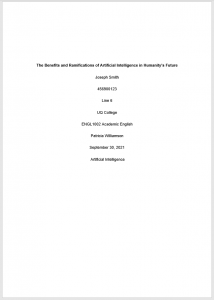
Header and Footer
APA does not use anything in the footer, however the paper does need a header with a page number and a copy of your thesis statement.
On the title page you will have the phrase Running Header: (no quotation marks and followed by a semi-colon before your thesis statement. The thesis statement begins with a capital letter) followed by your title or, in the case of your discursive essay, the thesis statement . Technically, the running header should be no more than 50 characters, including letters, spaces, and punctuation. Though in the case of the discursive essay, it is more important to your instructor / grader to have the thesis statement available to refer to on each page.
In the header and footer tab (click “Insert”, “edit header”) you can make the header on the first page different to the rest of the paper by checking the box that says “Different First Page.” In all headers that follow , you will not need the Running Header title, only the thesis statement . You can also decrease the Header margin from the top and use a smaller, less obtrusive, font – no smaller than 10 point font.
Running Header: The application of artificial intelligence is worrying to humanity and should be avoided, however there is a consensus that artificial intelligence promotes a promising future for humanity.
All following headers would only contain the thesis statement without the “Running Header” title.

You must also number each page, including the title page . In the header, tab to the far right , click the arrow on “Page Number” on the far left, then “Current Position” and finally, “Plain Number”. This will give you running page numbers, beginning on the title page. The number must appear in the top right-hand corner of the paper and must not include the word page or any abbreviation such as p., page 1 of.
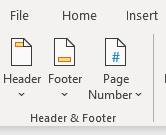
Please note, these instructions are for Microsoft Word and your personal device may vary.
If you have questions regarding any aspect of your assignment, please do not hesitate to ask your teacher for assistance.
Showing no prejudice for or against something; impartial.
Academic Writing Skills Copyright © 2021 by Patricia Williamson is licensed under a Creative Commons Attribution-NonCommercial-ShareAlike 4.0 International License , except where otherwise noted.
Share This Book
- Buy Custom Assignment
- Custom College Papers
- Buy Dissertation
- Buy Research Papers
- Buy Custom Term Papers
- Cheap Custom Term Papers
- Custom Courseworks
- Custom Thesis Papers
- Custom Expository Essays
- Custom Plagiarism Check
- Cheap Custom Essay
- Custom Argumentative Essays
- Custom Case Study
- Custom Annotated Bibliography
- Custom Book Report
- How It Works
- +1 (888) 398 0091
- Essay Samples
- Essay Topics
- Research Topics
- Uncategorized
- Writing Tips
How to Write a Discursive Essay
November 17, 2023
A discursive essay is a type of academic writing that presents both sides of an argument or issue. Unlike an argumentative essay where you take a clear stance and defend it, a discursive essay allows you to explore different perspectives and provide an objective analysis. It requires careful research, critical thinking, and the ability to present logical arguments in a structured manner.
In a discursive essay, you are expected to examine the topic thoroughly, present evidence and examples to support your points, and address counterarguments to demonstrate a balanced understanding of the issue. The purpose is not to persuade the reader to take a particular side, but rather to present a comprehensive view of the topic. By mastering the art of writing a discursive essay, you can effectively convey complex ideas and contribute to meaningful discussions on various subjects.
What’s different about writing a discursive essay
Writing a discursive essay differs from other types of essays in several ways. Here are some key differences to consider when approaching this particular form of academic writing:
- Explores multiple perspectives: Unlike an argumentative essay, a discursive essay examines different viewpoints on a given topic. It requires you to gather information, analyze various arguments, and present a balanced view.
- Structured presentation: A discursive essay follows a clear structure that helps organize your thoughts and arguments. It typically consists of an introduction, several body paragraphs discussing different arguments, and a conclusion.
- Impartiality and objectivity: While other essays may require you to take a stance or defend a particular position, a discursive essay aims for objectivity. You should present arguments and evidence without bias and demonstrate a fair understanding of each viewpoint.
- Importance of research: Good research is essential for a discursive essay. You should gather information from reliable sources, consider various perspectives, and present evidence to support your ideas.
- Addressing counterarguments: In a discursive essay, it is crucial to acknowledge and address counterarguments. By doing so, you show a comprehensive understanding of the topic and strengthen your own argument.
- Use of transitions: To maintain coherence and provide a smooth flow of ideas, appropriate transitions should be used to link paragraphs and signal shifts between arguments.
By recognizing these key differences and adapting your writing style accordingly, you can effectively write a discursive essay that engages the reader and presents a well-rounded discussion of the topic.
Step-by-Step Discursive Essay Writing Guide
Selecting a topic.
Selecting a topic for a discursive essay is a crucial first step in the writing process. Here are some considerations to help you choose an appropriate and engaging topic:
- Relevance: Select a topic that is relevant and holds significance in the current context. It should be something that sparks interest and discussion among readers.
- Controversy: Look for topics that have multiple perspectives and controversial viewpoints. This will allow you to explore different arguments and present a balanced analysis.
- Research opportunities: Choose a topic that offers ample research opportunities. This ensures that you have access to reliable sources and enough material to support your arguments.
- Personal interest: It is easier to write about a topic that you are genuinely interested in. Consider your own passion and areas of expertise when selecting a subject for your essay.
- Scope and depth: Ensure that the chosen topic is neither too broad nor too narrow. It should provide enough scope for thorough analysis and discussion within the word limit of your essay.
Remember, the topic sets the foundation for your discursive essay. Take time to consider these factors and select a topic that aligns with your interests, research capabilities, and the potential to present a well-rounded discussion.
Possible Discursive Essay Topics:
- The impact of social media on society.
- Should euthanasia be legalized?
- Pros and cons of genetically modified organisms (GMOs).
- The influence of technology on human interactions.
- Is homeschooling more beneficial than traditional schooling?
- The effects of climate change on the environment.
- Should animal testing be banned?
- The advantages and disadvantages of globalization.
- The ethics of capital punishment.
- The legalization of marijuana: pros and cons.
Write the Thesis Statement
The thesis statement in a discursive essay serves as the central argument or main claim that sets the tone for the entire essay. It typically appears in the introductory paragraph and guides the reader’s understanding of the essay’s purpose and direction. Here are some key points to consider when crafting an effective thesis statement for a discursive essay:
- Clear stance: The thesis statement should clearly express your position or viewpoint on the topic. It should present a concise statement that reflects your overall argument or analysis.
- Controversy: The thesis statement should highlight the controversy or debate surrounding the topic. It should indicate that there are multiple perspectives to be explored and that you will discuss them in a balanced manner.
- Specificity: The thesis statement should not be too vague or general. It should address a specific aspect of the topic that you will focus on in your essay.
- Clarity: The thesis statement should be clear and easy to understand. It should provide a clear sense of direction for the reader, indicating the main points that will be discussed in the essay.
- Strong and compelling: The thesis statement should be strong and compelling, capturing the attention of the reader. It should be a statement that provokes thoughtful analysis and discussion.
By considering these factors, you can develop a thesis statement that effectively sets the tone for your discursive essay and captures the essence of your argument or analysis.
Conducting Research
Conducting thorough research is a critical step in writing a discursive essay. Here are some essential tips to help you effectively gather information and sources:
- Define your research question: Clearly define the question or issue you want to explore in your essay. This will guide your research and help you stay focused.
- Use a variety of sources: Gather information from a diverse range of sources, such as books, scholarly articles, reputable websites, and academic journals. This will ensure a well-rounded and comprehensive understanding of the topic.
- Evaluate the credibility of sources: Assess the reliability and credibility of each source before including it in your essay. Consider factors such as author credentials, publication date, peer-reviewed status, and the reputation of the source.
- Take organized notes: As you read and review your sources, take organized notes to keep track of key points, quotes, and references. This will make it easier to cite sources accurately later.
- Analyze and synthesize information: Analyze the information you have gathered and synthesize it into coherent arguments. Identify common themes, patterns, and conflicting viewpoints that will form the basis of your essay.
- Address counterarguments: Remember to consider and address counterarguments in your research. Engaging with opposing viewpoints will strengthen your arguments and demonstrate a well-rounded understanding of the topic.
By following these research strategies, you can gather reliable and varied sources to support your discursive essay, ensuring a balanced and well-informed discussion of the topic.
Writing the Introduction
The introduction sets the tone and direction for a discursive essay, providing context and background information on the topic. Here are some key elements to include when writing the introduction to a discursive essay:
- Grab the reader’s attention: Use a hook or attention-grabbing statement to draw the reader in and generate interest in the topic.
- Introduce the topic: Clearly state the topic and provide some background information to contextualize the issue.
- Define key terms: Define any key terms related to the topic that may be unfamiliar to the reader.
- Present the thesis statement: Clearly state your main argument or claim, which sets the tone for the rest of the essay.
- Outline the structure: Briefly outline the main points or arguments that will be addressed in the essay.
- Write in a discursive style: Use a discursive style of writing in the introduction that presents multiple viewpoints on the topic.
By including these elements, you can craft an effective introduction to your discursive essay that engages the reader, establishes the context for the topic, and clearly presents your thesis statement. Remember to present a balanced analysis of multiple viewpoints, maintaining the discursive style of the essay.
Presenting Arguments and Counterarguments
Presenting arguments and counterarguments is a crucial aspect of writing a discursive essay. Here are some strategies to effectively structure and present your arguments and counterarguments:
- Identify key arguments: Begin by identifying the main arguments or perspectives related to the topic. These arguments will form the basis of your essay and provide a framework for your analysis.
- Develop supporting evidence: Gather relevant evidence, examples, statistics, or expert opinions to support each argument. This evidence should be well-researched and credible to strengthen your claims.
- Present arguments in a logical order: Organize your arguments in a logical and coherent manner. You can choose to present each argument separately, dedicating individual paragraphs to each one or use a point-counterpoint approach where you counter each argument with a counterargument.
- Address counterarguments: Acknowledge and include counterarguments in your essay to demonstrate a comprehensive understanding of the topic. Refute counterarguments by presenting contrasting evidence or providing a persuasive rebuttal.
- Provide balanced analysis: While presenting arguments and counterarguments, ensure a balanced analysis that gives due weight to each viewpoint. Avoid bias and strive for objectivity by presenting evidence from various perspectives.
- Use transition words and phrases: Utilize appropriate transition words and phrases to guide the reader through the presentation of arguments and counterarguments. Examples include “on the one hand,” “however,” “in contrast,” “nevertheless,” etc.
By following these strategies, you can effectively present arguments and counterarguments in your discursive essay, demonstrating a comprehensive understanding of the topic and engaging the reader in a thoughtful analysis.
Writing the Body Paragraphs
When writing the body paragraphs of a discursive essay, it’s important to present a balanced and well-structured analysis of the topic. Here are some key strategies to consider:
- Organize your paragraphs: Each body paragraph should focus on a single argument or idea. Start with a clear topic sentence that introduces the main point of the paragraph.
- Provide evidence and examples: Support your arguments with evidence, facts, statistics, or examples from credible sources. This will enhance the validity and persuasiveness of your arguments.
- Use logical reasoning: Present clear and coherent reasoning to connect your evidence with your main argument. Use logic and critical thinking to explain the relevance and significance of your evidence.
- Consider opposing viewpoints: Acknowledge potential counterarguments and address them within your body paragraphs. Refute counterarguments using logical and evidence-based reasoning.
- Use paragraphs for different viewpoints: If you’re discussing multiple perspectives or arguments within the same essay, dedicate separate paragraphs to each viewpoint. Clearly indicate transitions between paragraphs to maintain a coherent flow.
- Include topic sentences and transitions: Begin each paragraph with a topic sentence that clearly states the main idea. Use transitional words and phrases to guide the reader smoothly from one paragraph to the next.
Remember, in a discursive essay, the body paragraphs should explore various arguments and perspectives related to the topic, providing a balanced analysis and supporting evidence. By following these strategies, you can construct well-organized and compelling body paragraphs for your discursive essay.
Incorporating Evidence and Examples
Effectively incorporating evidence and examples is crucial in a discursive essay to support your arguments and strengthen your analysis. Here are some strategies to consider when integrating evidence:
- Choose credible sources: Gather evidence from reputable and reliable sources such as scholarly articles, books, authoritative websites, or academic journals. This ensures the validity and credibility of the evidence.
- Use a variety of evidence: Draw from a range of sources to provide a well-rounded perspective on the topic. This can include facts, statistics, expert opinions, case studies, or historical examples.
- Provide context: When presenting evidence, provide context to help the reader understand its significance. Explain the relevance of the evidence to your argument and how it supports your main points.
- Analyze and interpret evidence: Avoid simply regurgitating evidence. Instead, analyze and interpret it, explaining how it supports your argument and contributes to your overall analysis.
- Quote and paraphrase effectively: When using direct quotes, ensure they are relevant and support your argument. Use accurate paraphrasing to summarize and restate ideas from your sources.
- Cite your sources correctly: Properly cite your sources using a citation style appropriate for your academic field, such as APA, MLA, or Chicago. This gives credit to the original authors and avoids plagiarism.
By incorporating evidence and examples effectively, you can provide a solid foundation for your arguments in a discursive essay, enhancing your credibility and persuasiveness.
Addressing Counterarguments
Addressing counterarguments is an essential component of a discursive essay as it demonstrates critical thinking and strengthens your overall argument. Here are some strategies to effectively address counterarguments:
- Identify counterarguments: Identify the main counterarguments or opposing viewpoints related to your topic. This shows that you have considered different perspectives on the issue.
- Understand the counterarguments: Thoroughly analyze and understand the counterarguments before addressing them. This will help you develop a strong response based on evidence and reasoning.
- Refute the counterarguments: Present a persuasive rebuttal to counterarguments by providing evidence or logical reasoning that challenges or disproves them.
- Anticipate objections: Address potential objections or criticisms that readers might have. Proactively refute these objections by providing additional evidence or presenting alternative perspectives.
- Acknowledge validity: Recognize the validity of certain counterarguments or aspects of opposing viewpoints. This demonstrates fairness and strengthens your overall argument by showing that you have carefully considered all sides.
- Use transitional phrases: Use transitional phrases such as “however,” “although,” or “on the other hand,” to seamlessly introduce counterarguments and your responses.
By effectively addressing counterarguments, you can strengthen your own argument and demonstrate a comprehensive understanding of the topic. Engaging with opposing viewpoints in a fair and persuasive manner enhances the overall credibility and impact of your discursive essay.
Concluding the Discursive Essay
Concluding your discursive essay is an opportunity to summarize your main points and leave a lasting impression on the reader. Here are some strategies to effectively conclude your essay:
- Restate your thesis statement: Begin your conclusion by restating your thesis statement in a concise and clear manner. This reminds the reader of your main argument and reinforces its significance.
- Summarize your main points: Provide a brief summary of the main points you discussed in the body paragraphs. This helps to reinforce the key arguments and evidence presented throughout the essay.
- Emphasize the significance of your argument: Highlight the importance and relevance of your argument in relation to the broader context or real-world implications. This helps to leave a lasting impact on the reader.
- Address counterarguments: Briefly acknowledge the counterarguments you addressed in the essay and reiterate why your main argument is stronger or more compelling.
- Offer a final thought or call to action: Conclude your essay by offering a final thought, reflection, or call to action that encourages the reader to further consider the topic or take action.
- Provide closure: End your conclusion by providing a sense of closure to the essay. This can be achieved by offering a conclusive statement or returning to an anecdote or example mentioned earlier in the essay.
By following these strategies, you can effectively conclude your discursive essay, leaving a strong and memorable impression on the reader while summarizing the key points and reinforcing the significance of your argument.
Sociology Research Topics Ideas
Importance of Computer in Nursing Practice Essay
History Research Paper Topics For Students
By clicking “Continue”, you agree to our terms of service and privacy policy. We’ll occasionally send you promo and account related emails.
Latest Articles
Navigating the complexities of a Document-Based Question (DBQ) essay can be daunting, especially given its unique blend of historical analysis...
An introduction speech stands as your first opportunity to connect with an audience, setting the tone for the message you...
Embarking on the journey to write a rough draft for an essay is not just a task but a pivotal...
I want to feel as happy, as your customers do, so I'd better order now
We use cookies on our website to give you the most relevant experience by remembering your preferences and repeat visits. By clicking “Accept All”, you consent to the use of ALL the cookies. However, you may visit "Cookie Settings" to provide a controlled consent.
- Professional development
- Knowing the subject
How to approach discursive writing
Since writing is primarily about organising information and communicating meaning, generating ideas is clearly going to be a crucial part of the writing process.

Getting started, as much for people writing in their own language as for those writing in a foreign language, is one of the most difficult and inhibiting phases of the writing process. Idea generating is therefore key in facilitating the transition from thought to paper. A brainstorming activity is an effective way of getting ideas flowing.
- Brainstorming
- Assessing ideas
- A model text
- Focus on model text coherence
- Organising ideas
- Correction and reading
Brainstorming Brainstorming consists of group discussion. Students might discuss an idea, the answer to or reasons for a problem. In a lesson I taught recently I asked my students to brainstorm the reasons why people take drugs.
- Brainstorming involves thinking quickly and without inhibition, which can ultimately lead to an interesting piece of writing.
- The teacher should remain in the background during this phase, only supplying language support when students need it, so as not to inhibit students in the production of their ideas.
- Evaluating ideas during brainstorming can be intimidating, and can have a negative effect, limiting the creativity the process is designed to promote.
Assessing ideas The relevance and practicality of the ideas produced during brainstorming can be assessed more objectively in the next stage, that is in encouraging students to extend their ideas into a mind map, or spidergram.
- It is in this stage that students can judge the quality and usefulness of their ideas.
- A mind map or spidergram is also an organised display of information, which can be more easily converted into a draft.
- Such graphics also make the (hierarchical) relationship of ideas more easily obvious, which will help students with the structure of their texts.
A model text In my previous article, Process and product writing , I argued that it is possible to combine a process and product driven approach to writing. The above steps mentioned here have focussed on the varied classroom activities which promote the development of language use. It is these discussion stages, so important in helping students to decide what they want to say, that I believe to be of great importance from the 'process driven approach' . It is after these discussion stages, and the organisation of ideas in note form, that I tend to introduce a model text.
The reading of a model text, so important in a product driven approach to writing, is not so as to subjugate the students' ideas to their organisation, but so as to make students aware that there is a particular way to express their ideas. In this way students are given the form in order to enable them to adapt it to carry their own meaning. Ellis found evidence to suggest that "focusing learners' attention on forms, and the meanings they realise in the context of communicative activities, results in successful language learning." Focus on model text coherence Coherence refers to the logical development of ideas within a text and it is an important subskill for students to be aware of. The teacher can highlight this in various ways, by focusing on the topic and function of each paragraph for example, or by examining how the writer has chosen to order his arguments. This focus will hopefully show students that if they are to convey their message successfully, they will have to make their text 'reader friendly' .
Cohesion Cohesion refers to the grammatical and lexical connections between individual clauses. The grammatical links can be classified under three broad types:
- Referents (pronouns, the article "the", demonstratives)
- Ellipsis (leaving out of words or phrases where they are unnecessary)
- Conjunction (a word which joins phrases or clauses together)
Pronouns, whether subject (he), object (him), possessive (his), relative (who), or reflexive (himself), are often underused or misused by students while performing a writing task, resulting in either confusion as to the referent or tedious repetition of a noun.
One way of raising awareness of the key function that pronouns play within a text is to ask students to circle all the pronouns, then to use arrows to connect them to their referent. This shows students that pronouns can be found by looking back or forwards in the text.
There are many other activities that can be used to focus on cohesion. For example, asking students to replace a sentence which is missing from each paragraph, or to replace the first sentence of each paragraph, matching clauses which have been separated or gapping conjunctions which students must replace from a selection.
Organising ideas After raising students' awareness of the grammatical and stylistic devices employed in the model text, students should begin to organise their mind maps into a linear format, i.e., the text structure of the model text.
This provides students with an opportunity to further sift and/or logically connect their ideas, to focus them on the precise function of each paragraph, which will help to clarify their writing. They will also have to discuss the overall structure i.e., the order in which to relay their information, depending on the impact they wish to have on the reader. Groups All of the above activities work best if carried out in groups as groupings make the tasks livelier and more enjoyable. Moreover, if students can work together, assisting each other, then the atmosphere of the writing class may be less intimidating, and perhaps students will not be afraid of the complexity of writing tasks. Writing The next stage involves the learners in writing the first draft of their texts with a partner. This pair work will help students see that writing really is co-operative, a relationship between writer and reader. Usually, the writer has to imagine a reader, but co-operative writing provides each writer with a reader and makes the task more realistic and interactive.
Correction and Reading The first draft could be corrected in a number of ways, depending on your aims. The teacher could code-correct, or simply underline errors, then help the students to reformulate their first drafts with the aid of the model text.
Once the final drafts are written, the students should then exchange their compositions so that they become readers of each other's work. This gives their texts a communicative purpose, as well as developing an awareness of the fact that a writer is always producing something to be read by someone else, rather than for the display of writing alone.
Learning to write coherently, in a way suitable to one's purpose and one's audience, is clearly a very difficult task. However, writing is a valuable skill, one which is worth all the classroom time (and more) spent on it. If we, as teachers, can present writing as a stimulating process, and engage our students in the act of creating a text, then perhaps we can help them to improve the effectiveness of their writing.
Further Reading 'Process Writing' by Ron White and Valerie Ardnt 'Language Teaching Methodology' by David Nunan 'Progressive Writing Skills' by Will Fowler 'Discourse Analysis for Language Teachers' by Michael McCarthy
Written by Vanessa Steele, British Council, Barcelona
Research and insight
Browse fascinating case studies, research papers, publications and books by researchers and ELT experts from around the world.
See our publications, research and insight
How to Write a Good Discursive Essay?
05 June, 2020
7 minutes read
Author: Elizabeth Brown
What does a discursive essay mean? We have an answer to this and many other questions in our article. Welcome to the world of ideal essay writing. Ever wanted to build buzz for your text? We know you do. And we also know how you can do that with minimum effort and little diligence. So forget about your trivial academic essays - they are not as exciting as a discursive one. Ready to dive in?
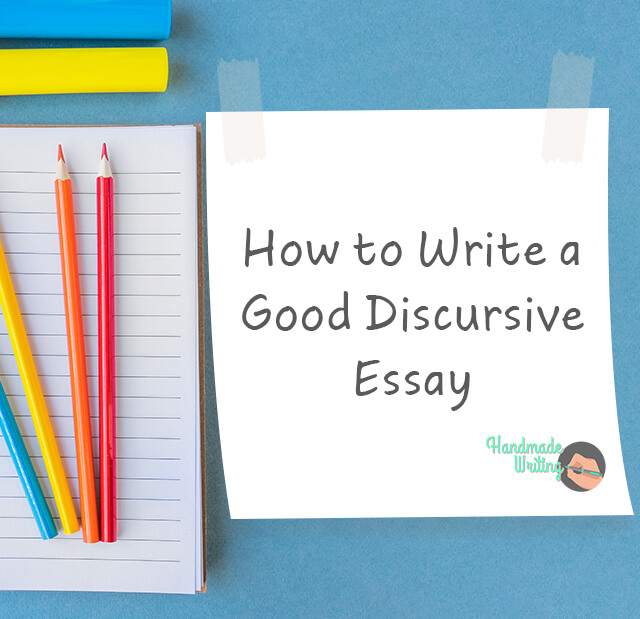
What is Discursive Writing?
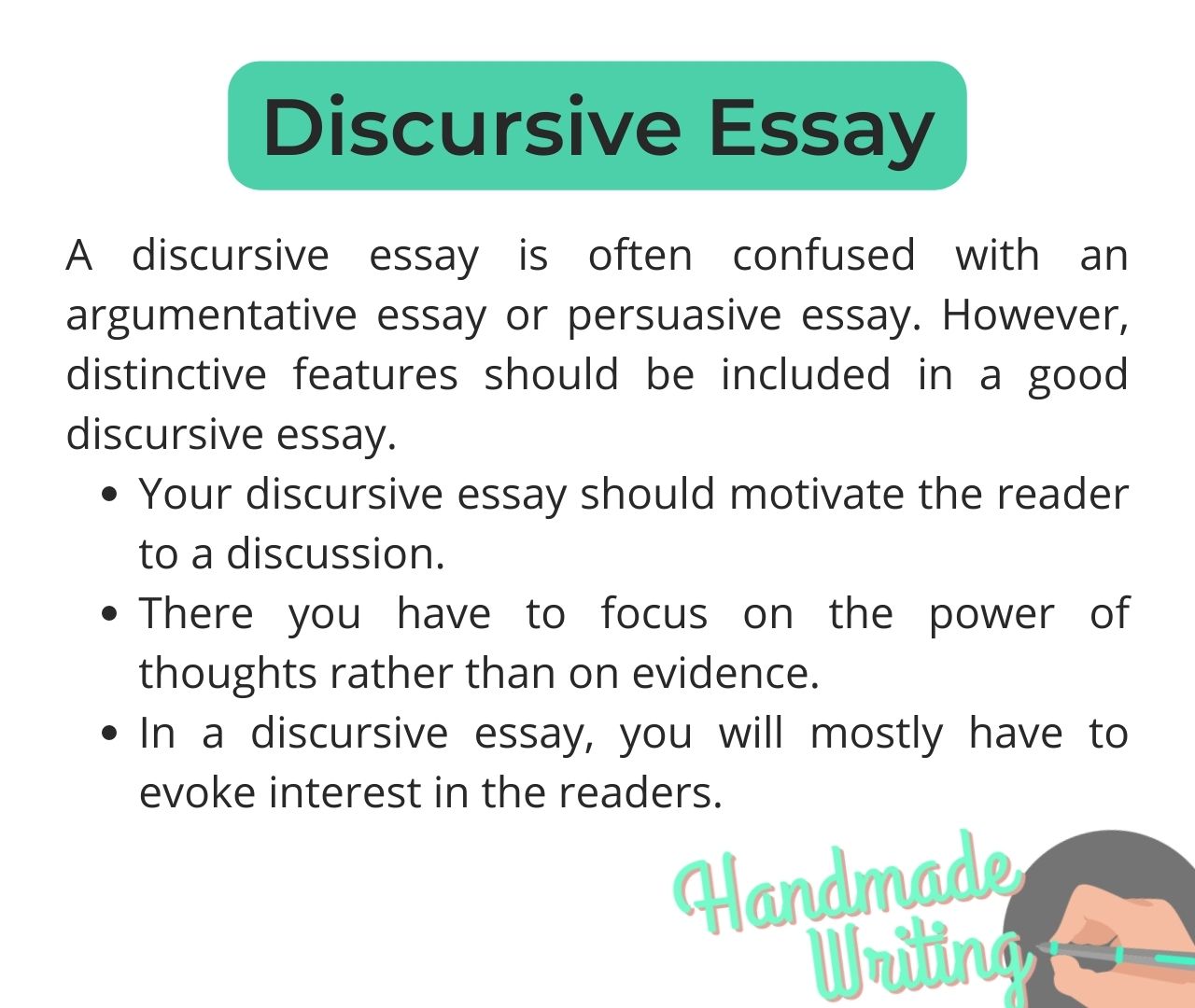
For all those who wanted to know the discursive essay meaning, here it is: a discursive essay is a writing piece, in which the focal element is devoted to an argument. That is, discursive writing presupposes developing a statement that ignites active discussions. After this essay, readers should be motivated to express their own opinions regarding the topic. Discursive essays have much in common with argumentative and persuasive papers, but these are not to be confused. Despite some similarities, discursive writing is a separate type of work that has its specific features and nuances. What we do want you to remember about discursive essays is that you need to concentrate on the power of thought rather than factology and pieces of evidence. In short, your mind is the only tool required to persuade and interest others on the topic you choose.
Discursive Essay Format
Now that we’ve figured out what is discursive writing, it’s time to focus more on the “skeleton” of discursive essay. Like any other piece of writing, discursive essays have clear requirements that help to glue their elements into a coherent paper. By the way, there are many writing services available which can help you present an excellent academic essay. So if you need professional assistance with your task, check them out. But if you want to do it yourself, you can simply take any discursive essay example from the web and use it as a starting point for your paper.

As for the discursive structure itself, you need to start your essay with an introduction in the first place. Create a lead-in that’ll spark the reader’s interest and make them genuinely responsive to the topic. Also, make sure that your introduction is neither small nor extensive. Stick to the optimal amount of words that’ll be sufficient for readers to get the general idea of your essay.
Another essential aspect of an effective intro is your opinion. It’s worthy of note that some discursive essays might require no particular stance on the topic. In situations like this, wait until the end of an essay comes, and only then share your personal view on the matter. This way, readers will understand the neutral tone throughout the piece, shape their own thoughts about it, and later decide whether to agree with yours or not.
In the paragraphs that follow, you’ll need to accentuate on the argumentation. There’s no room for vague and unarticulate expressions at this point. Quite the contrary – you need to unfold your statements consecutively, in a couple of paragraphs, to depict the entire image of your stance for or against the topic. And don’t forget to link your discursive text to supporting evidence.
The last section is the conclusion. Your finishing remarks should clearly articulate your position toward this or that issue, with a close connection to the main ideas in the essay body.
Discursive Essay Thesis
To construct a good thesis for your discursive essay, you’ll need to describe the general stance your work will argue. Here, it’s important to back up the thesis statement with points. These are the opinions that support your thesis and allow to create an affirmative structure for the entire paper.
Discursive Essay Linking Words

The points you use while writing a discursive essay need to flow smoothly so that readers could see a logical organization of the work. For this, you can use transition words that’ll make your paper easily readable and crisp. For example, if you want to list some points, opt for such words as firstly, to begin with, secondly, lastly, finally, etc. If you wish to point at advantages or disadvantages, consider using these transitions: the main/greatest/ first advantage of… is …, another positive side is…, an additional drawback is, another negative aspect of…is…
How to Write an Introduction for a Discursive Essay?
The introductory part is the critical aspect of creating a good discursive essay. In this section, specific attention should centralize on what your topic is all about. Therefore, it needs to be presented with clarity, be informative, and attention-grabbing. How to make your intro sentence for discursive essay memorable? You can start with a spicy anecdote to add humor to discussion. Another powerful way for hooking readers is stating a quote or opinion of experts and famous influencers. This will add to the credibility of your statements, making readers more motivated to read your work.
How to Write a Discursive Essay Conclusion?
Your discursive essay ending is the climax of your argument, a final link that organically locks up a chain of previously described points. This part is devoted to the restatement of the main arguments that sum up your attitude to the topic. And just like with introduction, the conclusion should leave a trace in readers’ minds. To achieve this result, your closing paragraph should include a call to action, warning or any other food for thought that will encourage people to ponder on the issue and make relevant conclusions.
Discursive Essay Topics
The ideas for discursive papers are so versatile that it’s hard to compile all of them in one list. For such list will extend to kilometers. However, we’ve collected some of them for you to facilitate your work on this task. So here are some discursive essay examples you can use any time:
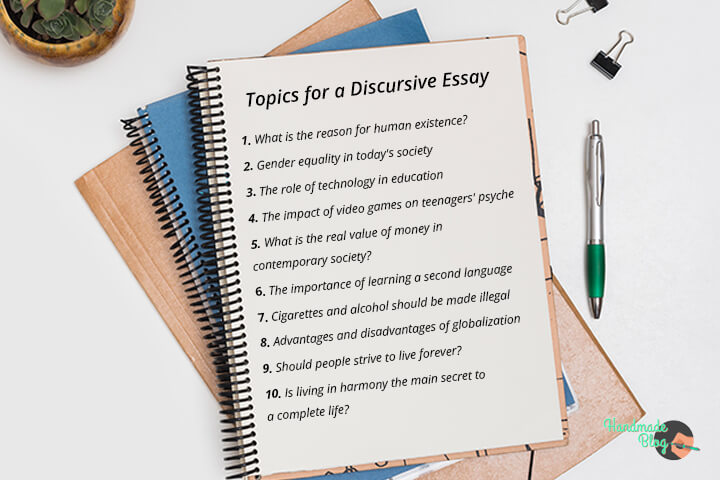
As you understand now, discursive writing definition and discursive essay definition are not as scary as they seem from the first glance. Even though the art of this type of paper is hard to master, over time, you’ll notice significant progress. All you need for this is practice and a little bit of patience to understand the subtle nuances of this task and develop the skill of writing confidently. And if you ever wondered what is an essay, a team of professional academic essay writers can give a helping hand and provide you with a top-notch paper.

A life lesson in Romeo and Juliet taught by death
Due to human nature, we draw conclusions only when life gives us a lesson since the experience of others is not so effective and powerful. Therefore, when analyzing and sorting out common problems we face, we may trace a parallel with well-known book characters or real historical figures. Moreover, we often compare our situations with […]

Ethical Research Paper Topics
Writing a research paper on ethics is not an easy task, especially if you do not possess excellent writing skills and do not like to contemplate controversial questions. But an ethics course is obligatory in all higher education institutions, and students have to look for a way out and be creative. When you find an […]

Art Research Paper Topics
Students obtaining degrees in fine art and art & design programs most commonly need to write a paper on art topics. However, this subject is becoming more popular in educational institutions for expanding students’ horizons. Thus, both groups of receivers of education: those who are into arts and those who only get acquainted with art […]

How To Write Discursive Essays
- Essay Writing Lower Secondary
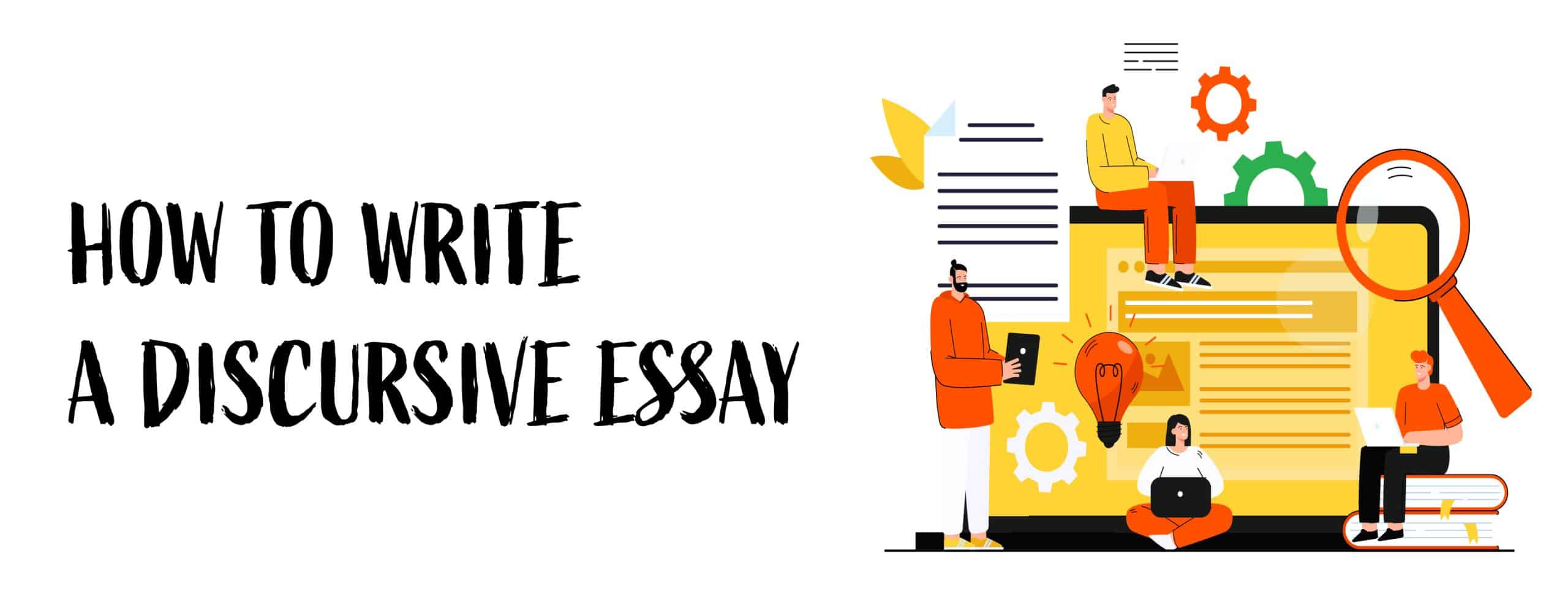
1. What is a Discursive Essay?
A discursive essay is an essay which involves a discussion. You’re encouraged to examine different perspectives on the issue so that the discussion you provide is a balanced one! You are on the right track if your essay sheds light on the issue by looking at it from different viewpoints.
But before you go on reading… You might want to download a pdf copy of this article as it is quite long!
Click the blue download button, enter your email, and the pdf file will be delivered to your inbox! (Remember to check spam!)
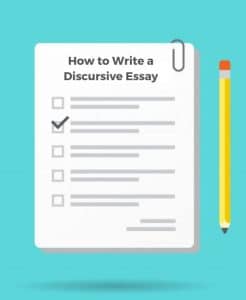
Click here to Download
2. How do I Identify a Discursive Essay Topic?
Let’s take a look at some of the discursive essay topics from past year papers:
2021 O-Level: “Young people are changing the world for the better.” What is your opinion?
- 2019 O-Level: “Most young people today are obsessed with fame and imitating celebrities.” What are your views?
In recent years, “What is your opinion?” and “What are your views?” are common signposts used to indicate a discursive essay topic. However, there are also instances where such questions are not used. Consider:
- 2012 O-Level: People all over the world are living longer. What are the advantages and disadvantages of their increased life expectancy?
- 2010 O-Level: What important lessons in life are learned away from school?
So note that the question can still indicate discursive writing even when it does not contain “What is your opinion?” or “What are your views?”
3. What is the Difference Between a Discursive Essay, an Argumentative Essay and an Expository Essay?

Now that we’ve cleared that up, let’s look at the differences in requirements for a discursive and an argumentative essay.
Argumentative: you are required to take an explicit stand on the issue. Your essay is structured in a manner that argues towards this stand. When writing an argumentative essay, your goal is to persuade, to convince the reader to be in support of your stand.
Discursive: you are not required to take an explicit stand on the issue. In other words, you do not need to pick a side. You may choose to pick a side; that’s perfectly fine! Just note that the goal here is not to persuade or to convince; it is to provide the reader with a balanced discussion by examining the issue from various viewpoints.
Now that you’ve learnt how to identify a discursive question and gotten a better idea of what it requires, let’s look at how to plan a discursive essay.
4. How do I Approach or Structure a Discursive Essay?

Some essays require a binary approach , meaning to say you tackle the issue by addressing the positive and the negative aspects of the question at hand.
Here is how you can plan your body paragraphs for such topics:
Now, it’s your turn! Try planning an outline for the following topics:
- 2017 O-Level: It is often said that people
- are too concerned with getting things and spending money. What is your opinion?
On the other hand, there are topics which are not suited for such a binary approach. Consider questions such as:
- Give 3 x features (1 per body paragraph)
- Give 3 x important lessons (1 per body paragraph)

5. How do I Brainstorm Ideas for a Discursive Essay to Achieve a Balanced Discussion?
Give yourself 10 minutes to do a proper planning. It’s useful to approach the issue at hand by exploring its significance and relevance in different spheres and domains : Education, Ethics or Morals, Technology, Law etc.
Instead of giving 3 different points from an education perspective, why not broaden your scope and look at the issue from not just an educational perspective, but also a technological perspective and an ethical perspective?
This is what makes for a matured, holistic response.
Let’s use the following topic as an example:

If you run out of ideas, you can also examine two sides of a coin in a single domain. For example, you’ll see that in the example, that for the technological sphere, there are instances of youths making and not changing the world for the better.
Now that the brainstorming is done, let’s put pen to paper and start writing!
6. How do I Write an Introduction for a Discursive Essay?
- Share an insight or observation regarding the issue. Why is this issue worth discussing? What are the implications of the issue? You can also use 5W1H questions to help you generate ideas.
- Define your scope of discussion and if needed, define the keywords in the topic by setting out what is meant by, for instance, “young people” and “for the better”.
You can ask yourself these questions to help you with your intro:
- Who are “young people”?
- In which domains are youths making significant impact?
- Why do some people believe that they are making the world a better place?
- Why do other people not trust youth to positively impact the world?
- What is my thesis?
Simply answer these questions + include your thesis. Voila, you have a solid introduction!
7. How do I Write the Body Paragraphs for a Discursive Essay?
Students, you must have heard of the PEEL method by now. We introduce the POINT in the first sentence, ELABORATE on the point, then substantiate with EVIDENCE or EXAMPLES , and finally, we round it all off by LINKING back to the point.
It sounds easy enough, doesn’t it?

Each body paragraph should only discuss one main idea , and only one! Introduce the main idea in your topic sentence (the first sentence of your body paragraph), not after you’ve given your example or when you’re wrapping up the paragraph.
A good topic sentence is straightforward and clear .
Here is an example of a coherent and concise topic sentence:
- In the sphere of education, youth activists are making positive changes by advocating to make education available to girls in less developed societies.
After you have crafted your topic sentence, it’s time to elaborate on your main point. A well-developed body paragraph elaborates by delving deeper into the main point and substantiating with relevant examples or evidence.
For our point on “education”, consider asking and answering the following questions:
- Education imparts knowledge and skills to girls, which then grants more employment opportunities. In turn, they break free from the poverty cycle.
- Don’t stop here! Make sure to link back to the idea of “making the world a better place”.
- This means lower poverty rates in the world and society also benefits from the contributions that the girls go on to make in the workforce.
Important Reminders:

a. Your essay must not be example-driven ! It must always be point-driven.
b. Remember to make the link from your examples/ evidence back to your topic sentence. This illustrates the relevance and strength of your evidence and reinforces your main point.
For our example, a coherent body paragraph could look like this:
8. How to Write a Conclusion for a Discursive Essay?

Many students just reiterate the points in conclusion. But that is… you guessed it, boring. Last impression lasts! You want to provide an insight to this issue to demonstrate your maturity of thought. Apart from summarising your points, link your conclusion back to the introduction so that your essay comes a full circle. You can also use a quote or thought-provoking question for readers to make their own conclusion.
Students, this is how you tackle a discursive essay. Try applying these tips to one of the topics above!
Visit other related articles on Writing Samurai:
How to write argumentative essays.
- 7 Exam-Smart Tips For Language Editing
- 9 Tips for English Summary Writing
- Practice Past Years O-Level English Essay Questions
- Exam Smart Tips for Secondary English Paper 1 and Paper 2
You might want to download a pdf copy of this article for future reference!
Click here to Download

Follow Writing Samurai on Telegram for the latest tips and strategies for English, Chinese, and Creative Writing! Pssst... We will also share the latest compo topics during test or exam season!
Click this link to follow our channel >>> https://t.me/writingsamurai
A Guide On How To Prepare for PSLE
Cancel reply
Your comment ...
Leave a Reply Cancel reply
Your email address will not be published. Required fields are marked *

Writing Samurai is an online platform dedicated to nurturing children’s creative writing skills. Our courses are designed to be engaging and effective, without resorting to traditional teaching methods.

Subscribe for latest news & English tips:
Primary english.
- Model Composition Examples
- Situational Writing Tips
- PSLE English Oral Exam Tips
- PSLE Chinese Oral Exam Tips
- 50 Meaningful Proverbs
- Composition Writing
- PSLE Marking Scheme

SECONDARY ENGLISH
- Past Year's O-Level Essays
- Discursive Essay Writing
- Argumentative Essay Writing
- Secondary English Writing Tips (O-Levels)
- Exam Tips for Secondary English
- 7 Exam Tips for Language Editing (O-Levels)

POPULAR TOPICS
- English Oral
- Chinese Oral
- Situational Writing
- Secondary School Writing
- Synthesis & Transformation
TOP FREE RESOURCES
- Free English Writing Resources List
- Free Model Compositions
- Video - Proverbs Composition Writing
- Video - How to Write A Powerful Introduction
- Video - How to Use Good Expressions in your Compositions
- Free Online Writing Course - Kick Start Your Writing
TOP COURSES
- Junior Writers Masterclass - P1 / P2
- Little Writers Masterclass - P3 / P4
- Creative Writing Masterclass - P5 / P6
- Chinese Composition Writing - P5 / P6
- Essay Writing Masterclass - S1 / S2
- Essay Writing - Expository & Argumentative Crash Course
- Grammar Editing Crash Course for Secondary School

How to write discursive text with examples included

Ex-tutor & HSC Band 6 All Rounder @YK Education
Writing a discursive piece can be a daunting task. Discursive texts give us a considerable amount of freedom in terms of how we may structure our piece, which perspectives we will explore, and the writing style we adopt. This can be an exciting opportunity to express our own opinion and use our voice, however the lack of a standard structure may mean it can be difficult to know where to start. The form demands that we explore a range of perspectives on a topic. This means looking at an issue from many sides, and potentially coming up with our own opinions. A personal discursive piece is often a relatable provoking discussion and could end with a reflective resolution but no clear argument. We will then unpack the various perspectives we have explored through employing figurative language, anecdotes, statistics, quotes and other literary devices.
Here is the definition of discursive texts from the NSW Department of Education:
“Discursive texts are those whose primary focus is to explore an idea or a variety of topics. These texts involve the discussion of an idea(s) or opinion(s) without the direct intention of persuading the reader, listener or viewer to adopt any single point of view.
Discursive texts can be humorous or serious in tone and can have a formal or informal register. These texts include texts such as feature articles, creative nonfiction, blogs, personal essays, documentaries and speeches.
Discursive is about exploring a range of perspectives on an argument. We can flicker between two perspectives. Then we unpack these perspectives by using figurative language to express ‘evidence’ for these perspectives in the wider World.”
A discursive text will:
- Explore an issue or idea and may suggest a position or point of view
- Approach a topic from different angles and explore themes and issues in a style that balances personal observations with different perspectives
- Use personal anecdotes and may have a conversational tone
- Primarily use first person although third person can also be used
- Either use figurative, descriptive language or may take a more factual approach
- Draw upon real life experiences and/or draw from wide reading
- Use engaging imagery and language features
- Begin with an event, an anecdote or relevant quote that is then used to explore an idea
- Have a resolution that may be reflective or open-ended.
What are the pros and cons of discursive texts?
We can be as personal as we want! Use any kind of tone, and we can even incorporate humour in our writing – just remember to use it in moderation. We are able to venture through our own personal thoughts, beliefs, and life experiences, which might be more interesting to write about. Our piece can be open-ended, and you definitely don’t need to have a conclusive point that you have to prove.
Sometimes, the freedom we have in a discursive text can be intimidating and we might not know where to start Structure and language-wise, a discursive text is really flexible, but this means that our ideas have to be very insightful, well thought out and complex, while our writing needs to be strong and effective. It’s easy to accidentally write a persuasive text instead! The way around this is to remember that you aren’t trying to argue for a specific point, you’re exploring different ideas. That means you don’t and shouldn’t talk about only one side of the argument, but think about counter-arguments, or at least different perspectives.
What to include in our discursive?
Deciding on a topic for the discursive text is an important first step; the topic must be a compelling and nuanced (or complicated) issue that you can write extensively about. Discursive texts often reflect social concerns, controversial topics or raise significant questions. Along with researched evidence on the chosen topic, to spice it up, make sure you include examples from real life experiences, quotes, interviews, references to popular culture, historical events and/or personal anecdotes. Importantly, a discursive piece does not need a clear conclusion! If you are struggling to come up with a central topic, consider some issues that impact or otherwise matter to us, e.g. your community (family, friends, local neighbourhood, school etc.), or the wider society (national or international).
How can I start a discursive piece?
To begin with the introduction, introduce your main overarching point that directly addresses the question. Remember to avoid writing an overly argumentative or one-sided thesis! The purpose of a discursive is to discuss more than one perspective. Instead, invite the readers to consider the complexities of a topic, and to introduce the many different perspectives on that topic.
Here’s an example :
Argumentative thesis: Unlimited access to technology has had a devastating impact on the social skills of using people.
Discursive thesis: Technology has, for better and worse, irreversibly changed the way we interact with each other. However, as much as things have changed ever since the first message sent on MSN there are some things that, for better and worse, remain the same.
Introduction:
- Introduce our main, overarching point that directly answers the question
- Other perspectives: what other perspectives will we be introducing to deepen our understanding of the subject matter? (Talk about at least two perspectives)
- Rhetorical question: prompt the reader to contemplate on the topic Anecdote: connect with the reader by speaking of our own personal experiences
- Proverb or quotation
Where will you see discursive texts?
Discursive texts are really everywhere! Opinion pieces in newspapers are an example – we’ll notice that many of them explore more than one perspective. Other examples include essays we’ll read, speeches and lectures. Many TedX talks are actually discursive as well. Notice some of them explore many different perspectives and angles on a specific idea!
Where can you find examples?
We can find some of the best examples of discursive writing in newspapers, as well as news sites. Below are some examples to get us started. Explore and find where else you might notice discursive writing!
- The New York Times Opinion Section
- The Economist
- The Guardian Opinion Section
- The Conversation
- Harvard Business Review
If you’d like to see discursive examples right now, send us an email and we’ll send some over to your email. You’ll also get a scaffold to write your own discursive!
Get more study tips
Receive monthly study tips and educational content that will help you ace your final years of High School!
You have successfully joined our subscriber list.
How to Study Effectively this Autumn School Holiday 2023

- Your infomation will never be shared with any third party
How to Write a Discursive Essay: Tips to Succeed & Examples
So, you need to accomplish your discursive essay writing. The typical questions most students ask are: How do you write it? What is discursive essay?
Our specialists will write a custom essay specially for you!
A discursive essay is an academic paper that involves a discussion on a particular topic. It is usually assigned to college students. You may be required to write a paper wherein you have to do one of the following:
- argue for the issue or against it;
- present your points of view on both sides;
- provide your unprejudiced opinion on that matter.
Don’t panic!
Check out the tips from Custom-writing.org experts below. They will assist you in discursive writing and encourage you to examine essay examples. Moreover, in this article, you’ll also learn about different types of discursive essay, and its introduction, main body, and conclusion structure.
- ❓ What Is It?
- 🏁 Main Types
Introduction
- Basic Don’Ts
- ✏️ Frequent Questions
❓ What Is a Discursive Essay?
First of all, let’s figure out what the discursive essay is.
You may think it’s similar to the argumentative essay. Yes, but there’s a difference between them in the structure and purpose of these two types of assignments:
Just in 1 hour! We will write you a plagiarism-free paper in hardly more than 1 hour
We will take a detailed look at how to structure a discursive essay later, and now let’s find out what are the types of this assignment.
Keep reading!
🏁 Discursive Essay: Main Types
You have to think more critically and more in-depth when reviewing all viewpoints and aspects of discursive writing. Check these three main types of essay writing:
- Opinion Essay requires the author’s opinion on an issue which is stated in the introductory paragraph. It should be clearly presented and followed by reasons and supporting examples. Also, this essay paper should contain an opposing argument that comes before the conclusion. The writer must explain to readers why the mentioned argument is considered to be unconvincing. The writer’s opinion should be restated/summarized in the conclusion.
- For and Against Essay provides readers with a thorough debate on the topic with the help of opposing points of view. Each point should be discussed objectively and described in details. The introductory paragraph puts the issue under consideration. The main body of this essay paper should present examples, reasons, and arguments supported by justifications. The author’s own opinion with balanced reflections on the topic should be stated only in conclusion.
- Essay Suggesting Solution to a Problem discusses problems and finds the main solutions. The introduction paragraph explicitly declares a problem and analyses its causes and consequences. The main body of the essay should offer some suggestions for a possible solution to the problem and potential state consequences or expected results. In conclusion, author’s opinion should be distinctly summarized.
📑 How to Write a Discursive Essay
Well, it’s time to talk about the structure of a discursive essay. Like most of the assignments, a discursive paper starts with an introduction and ends with a conclusion:
The first question you may ask is how to start a discursive essay introduction. Simple!
Receive a plagiarism-free paper tailored to your instructions. Cut 20% off your first order!
- Give your readers a hook – something that would sound interesting to them.
- Provide a short explanation of the problem. You may use quotations, as well as rhetorical questions.
- Show your readers both sides of the arguments and sum up.
You may be wondering…
Is there something I should avoid in my discursive essay introduction?
Yes. No stereotypes and generalizations, please!
The next step under formal essay writing you should take is to compose the body.

There are a few points you should remember:
Get an originally-written paper according to your instructions!
- First and foremost: stay unprejudiced . Assess all of the aspects of an issue. Leave your feelings behind or for another essay type.
- Second: build your argumentation . If you have several arguments for your viewpoint—provide them in separate paragraphs. This will help you to keep your essay comprehensible and distinct. Don’t forget to submit supporting evidence.
- Third: write the body of an essay in an alternate manner. What does it mean? If your first paragraph supports the paper’s argument, then in the second paragraph you should write something in the opposite of it. Such a combination of supporting and opposite paragraphs will make your essay look apparent, and well researched. Besides, it will help you to remain neutral.
- Fourth: include topic sentences and evidence . Write a summary of the argument at the beginning of the paragraph. It will allow the reader to easier understand what the paragraph is about. Provide evidence to show that you’re not making the facts up.
Well, you’ve almost finished your writing. Now you should focus on the last section. Keep reading, and you will learn how to write a conclusion for a discursive essay.
- In the last section, you should summarize your article including the main points, specified in the body paragraphs.
- You may also logically express your opinion. Remember: it should resonate with your evidence stated in the body paragraphs.
- Don’t repeat findings, just summarize them.
Keep it short. Your conclusion length should not exceed one paragraph.
👍 Do’s and Don’ts
Do you want more discursive essay writing tips? Fine! Just check them below:
Basic Do’s of a Discursive Essay
- Write in formal, impersonal style.
- Introduce each point in a separate paragraph
- Use topic sentences for each paragraph
- Write well-developed paragraphs
- Give reasons and examples for each point
- Use sequencing
- Use linking words and phrases
- Make references to other sources and make sure that you follow proper citation style
- Identify used sources
Basic Don’Ts of a Discursive Essay
- Don’t use short forms, like I’ll, don’t, they’ve
- Don’t use informal/colloquial language, for example: old as the hills, ain’t, gonna, etc.
- Don’t use very emotional language, since it might make your discursive article look prejudiced
- Don’t use over-generalizations. Extending the features of some elements from a group more than it is reasonable will lead to generous and inaccurate conclusions.
- Don’t express your personal opinion too insistently
- Don’t refer to statistics without proper referencing (check our citation guides )
- Don’t use personal examples, leave it for a personal experience essay
Well, now you know what discursive essay means, what are its main types, and how to structure it.

Discursive Essay Topics
- Discussion of risk factors that impact human health.
- Discuss the necessity of understanding cultural heritage to provide efficient health care.
- Analyze different opinions on withdrawing patients’ treatment.
- Examine different views on the Civil War .
- Discuss what hostile emotional states are and how they impact human life.
- Discuss the meaning of metaphors used by Virgil in Aeneid .
- Describe different opinions on telehealth in nursing homes.
- The ethicality of stem cell technology.
- Explore the effectiveness of motivational interviewing .
- Discuss how people present themselves online .
- Discuss the reasons for Coca-Cola’s marketing success.
- Analyze the food safety issues and the ways to improve the situation.
- Examine the essential meaning of sleep for people’s physical and mental health.
- Explore various complications of working with groups .
- Discussion of the modern issues with virtue ethics .
- Describe different views on the definition of love .
- Give the for and against arguments considering food security technologies .
- Discuss how the concept of the American dream is presented in the film The Great Gatsby .
- Analyze the influence of family problems on children and suggest ways to improve the situation.
- Present the various points of view on the ethical concepts of Buddhism .
- Examine the attitudes towards the problem of homelessness and the suggested ways of its solution.
- Explore different opinions on the American revolution and its consequences.
- Discuss various policies and views around the globe on abortion .
- Discussion of the history of food foraging in different communities.
- Multiple thoughts on civility on the Internet .
- Analyze arguments on the effectiveness of hand sanitizers .
- Discuss the importance of visual aids in learning.
- Present and evaluate the theories of international development .
- Discuss how to prevent the spread of the West Nile Virus (WNV).
- Is embracing renewable energy sources beneficial for both environment and the global economy?
- Examine the correctness of the statement that the ideology of pleasure is the foundation of social activism .
- Discussion of the ethical dilemma of population control.
- Discuss the ethics of experimental studies .
- Analyze the topic of gun violence and gun control laws.
- Explore the reasons for opioid crises in the US.
- Give arguments for and against random drug testing .
- Discuss the problem of endangered species .
- Express your opinion on the necessity of parents to be included in children’s education .
- Present your attitude towards working in a bureaucratic organization .
- Discuss the issue of the nursing shortage and suggest a solution.
- Give different viewpoints on the definition of beauty .
- Analyze the problem of police misconduct .
- Discuss the description of violence of African people in literature .
- Examine the views on Gardner’s multiple intelligence theory .
- Describe the various opinions on mysticism and express your attitude towards it.
- Discuss the diverse standpoints on spirituality .
- Is nature protection an urgent problem?
- Analyze different ideas on physical privacy at work .
- Discussion on the Jewish heritage in nursing.
- Examine the views on the meaning of life .
Good luck with your discussions and discursive essays! Be sure to check out the articles on our blog for more academic wisdom. By the way, on the Custom-Writing website, you may find the best essay topics for your academic writing.
And don’t forget to share your opinion in the comments below.
You might also be interested in:
- Friendship Essay: Writing Guide & Topic Ideas about Friendship
- Teamwork Essay: Quick Guide on How to Write a Good Paper
- Compare and Contrast Essay Writing Tips and Examples
- Transportation Essay: Writing Tips and Brilliant Topics
✏️ Discursive Essay FAQ
There is no one definitely correct answer to this question. Like any other essay, the text should have a clear structure with an introduction, body, and conclusion. The most important thing is that the overall book needs to be cohesive, persuasive, and exciting to read.
An example of a step by step guide is:
1. Take a closer look at the topic, think about the points to cover.
2. Choose the most relevant points and compose the Body of the essay.
3. Add an appropriate Introduction and Conclusion.
To write a good conclusion, you need to have the rest of the essay finished. Does the body of your essay present well-structured points? Great, then see what you can conclude based on that. If possible, make a connection between the introduction and the conclusion.
To ensure that your essay has a perfect structure, start with creating an outline. Based on such a plan, you can present your points step by step. Your text should have a relevant introduction, several points in the main body (with examples), and a logical conclusion.
🔗 References
- Writing an Opinion Essay: Grace Fleming, ThoughtCo
- How to Write a Good Argumentative Essay: Easy Step-by-Step Guide: Master Class
- Ending the Essay: Conclusions: Harvard College Writing Center
- Academic Writing Style: University of Southern California
- Cite Your Sources: Library Guides at University of California, Santa Cruz
- Share to Facebook
- Share to Twitter
- Share to LinkedIn
- Share to email

How to write a narrative essay? To do that, you need to know what a narrative essay is. It is an academic text usually written as a story and containing all the usual elements of a story. Narrative essays are often personal, experiential, and creative. Still, they should be made...
![discursive writing features College Essay Writing 101—the Comprehensive Guide [2024]](https://custom-writing.org/blog/wp-content/uploads/2021/01/student-girl-making-notes-in-a-copybook-with-a-pencil-e1565634333206-284x153.png)
So, you can’t wait to get into college and join a fraternity, sorority, or student union. Well, we have some incredibly useful tips and helpful information for college admission essay writing! Remember: getting into college takes more than money. And outstanding essays get you great college scholarships!
![discursive writing features Americanism Essay: Examples, Tips & Topics [2024 Update]](https://custom-writing.org/blog/wp-content/uploads/2020/12/american-flag-284x153.jpg)
It’s not hard to see why Americanism is one of the most popular essay topics. The concept of Americanism is in the center of the US identity. Writing an essay about it is an excellent way to find out more about this great country.

An art critique paper involves a comprehensive analysis and assessment of an artwork. Though this looks a bit complicated, the task doesn’t require a lot of time if you have sufficient critique writing skills. It’s an interesting assignment for students of art colleges as well as high schoolers. All you...

An article review is an academic assignment that invites you to study a piece of academic research closely. Then, you should present its summary and critically evaluate it using the knowledge you’ve gained in class and during your independent study. If you get such a task at college or university,...

Short essays answer a specific question on the subject. They usually are anywhere between 250 words and 750 words long. A paper with less than 250 words isn’t considered a finished text, so it doesn’t fall under the category of a short essay. Essays of such format are required for...

When you hear the phrase “spiritual leadership,” you probably think it’s only associated with religion. But did you know that this form of leadership can also be found in business? The book Spiritual Leadership: Moving People on to God’s Agenda by Henry and Richard Blackaby is a good starting point...

High school and college students often face challenges when crafting a compare-and-contrast essay. A well-written paper of this kind needs to be structured appropriately to earn you good grades. Knowing how to organize your ideas allows you to present your ideas in a coherent and logical manner This article by...

“If a tree falls in the forest, does it make a sound?” is one of the most debatable philosophical questions regarding observation and perception. Many tried to answer it, including the English philosopher John Locke. Do you need to explore Locke’s perspective on this question in your essay? You are on the right...

The long-standing debate surrounding abortion has many opponents and advocates. Groups known as Pro-Choice and Pro-Life argue which approach is better, with no easy solution in sight. This ethical complexity is what makes abortion a popular topic for argumentative writing. As a student, you need to tackle it appropriately. If...

What is the most important part of any essay or research paper? Of course, it’s the thesis statement—a sentence that expresses the paper’s main idea and guides the readers through your arguments. But where do you place the thesis? You’ve probably answered, “in the introduction.” However, that’s not all of...

If you’re a student, you’ve heard about a formal essay: a factual, research-based paper written in 3rd person. Most students have to produce dozens of them during their educational career. Writing a formal essay may not be the easiest task. But fear not: our custom-writing team is here to guide...
It’s very helpful!

Glad to hear that! Thank you for your feedback!
it’s a good site to learn from. However, it will be perfect if there is a small essay to clear the mess understanding from the advice
This was so helpful , thank you God bless you
Thanks for the feedback! Your opinion is very important for us!
Very good site,thank so much for your effort in writing the posts.
Thank you, Tameka!
thank you my n word 👨🏿🦳
thank you so much!!!! is there any way to access an annotated example to help?
Thank you so much. That really helped me with writing my essay.
thanku so much for increasing my knowledge
Thanks for the feedback, Malik! Much appreciated.
Thank you. It was really helpful. It has answered all my questions.
Thank you for your feedback, Martha. It means a lot for us!

Content Writers
What is discursive writing?
Discursive writing is a type of content usually found in the form of blogs, articles, essays and speeches. Discursive writing is characterized by being subjective or opinionated in nature and engaging the reader by focusing on questions and ideas. It typically has more than one argument or point of view, all of which are meant to debate with each other in order to come up with a conclusion.
This type of writing is usually informal and conversational in nature. It works by using both persuasion and “give-and-take” interaction to engage the reader and gain their interest. It can sometimes also be written in a formal style, with this variant used for academic writing, but discursive writing that is formal would still have the characteristics of one complementing the other.

How do you write discursive writing?
Discursive writing is not easily classified as there are no specific parameters that can be used to recognize it. This makes it important to know what the parameters are when recognizing a piece of work as discursive, in order to properly understand it.
When writing discursively, there are certain qualities that need to be present in order for the reader to recognize that the article or speech is discursive and not something else. There are six things that typically make a piece of writing discursive:
- Language used to create a tone that is informal. There are numerous colloquial terms and phrases, for example, that would demonstrate a casual and conversational tone, like saying “I hope you know what I mean here” or just “means.”
- Discursive writing often uses dialogue in order to specify or clarify an argument. This is when one writer will address another, or several other writers, instead of the reader directly. This is completely fine in a discursive piece, as long as it doesn’t feel like the writer is addressing the reader directly.
- Discursive writing often has more than one argument. This is something that people tend to struggle with when they try to write discursively, but what they don’t realize is that this is actually a good thing. Having more than one argument allows for more discussion and debate and will help in having the writer interact with what they have written.
- Subjectivity is a very obvious trait of discursive writing. This is when the writer takes an opinion that they have in order to express it to another person or people.
- Discursive writing often uses humour and wit in order to make the reader smile, laugh, or otherwise engage with the writer.
- Discursive writing is not usually restricted to a certain form or structure, as long as it is easy for the reader to understand.
Where can you find discursive writing?
Discursive writing can be found anywhere there is a writer who wants to express their opinion or question and help others make sense of the situation they are talking about. This means that you can find discursive writing in places of everyday life, as well as online.
Discursive writing can be found on blogs and personal websites, which are both places where you will typically see this type of writing, due to them having the highest level of freedom. Discursive writing can also be found in speeches and papers written by university students about various topics.
How can discursive writing be useful to you?
Discursive writing is very useful in helping the writer engage with the reader or listeners through a mutual dialogue or conversation. These “conversations” often lead to a conclusion, which will help others understand what it is that the writer wants them to know. This process greatly helps other people understand what it is you are trying to say, as they are able to discuss and debate your points with you.
It also helps to gain a deeper understanding of the topic that you are writing about, as you will be able to clarify your own thoughts and opinions. This can help others see your point of view, and understand why you hold that opinion in the first place.
Discursive writing is also useful in helping you to become a better writer and speaker by allowing you more opportunities to write, speak and debate in order to engage with others. This can help you become more comfortable and confident when speaking out, as you will have had the chance to practice and improve.
It can also help you become more organized and constructive in your writing, as discursive writing does not usually follow an exact structure or pattern. This forces the writer to be able to organize their ideas in their head before writing them down.
Discursive writing also helps you reach a larger audience through the use of discussion boards, blogs and other forms of social media. This allows your work to be shared easily and talked about by people from all over the world.
What are the common mistakes in discursive writing?
There are two things that can make discursive writing less effective and harder to understand. The first is when it is written in an unclear manner that gives the reader little to no idea about what the writer is trying to say. This can often be a result of poor grammar, spelling errors or inconsistencies in punctuation.
Discursive writing will also suffer if it does not have a sense of direction or focus. This is often a result of writers who try to say too much or cover too many areas, which will cause them to jump from point to point and leave the reader confused.
What are some examples of discursive writing?
You can find discursive writing in books, movies, speeches and in everyday conversation. There are various types of discursive writing, such as personal communication and philosophical writing. Some famous writers that write discursively are William Faulkner and William Shakespeare.
You will also see a lot of discursive writing from people who write blogs. Blogging allows for a writer to express their opinion on any number of topics without having to follow a set structure or strict guidelines. This allows for very freedom in their writing, but it also makes them more vulnerable.
Is discursive writing a good way to learn how to write?
Discursive writing is a great way to learn how to write. It can help you develop and improve many different skills that are involved in becoming a better writer. These include things like communication, organization and speaking. It will also help you become more confident and articulate in your own writing, allowing you to express your ideas more clearly and effectively.
When is discursive writing, not a good idea?
You should be wary of discursive writing if you are not sure of what you are trying to say. If you are unsure whether your ideas make sense or whether you can back them up, then it may be better for someone else to write the article for you in a more structured and concise manner.
You should also avoid discursive writing if your ideas are too complicated or controversial. This is because it will be hard for people to agree on what you are saying. You should also avoid discursive writing if your ideas are too technical. This is because not everyone will understand your writing and not everyone will agree with it.
Discursive writing as you can see is a great way to learn how to write. It is a fun and very engaging way to learn. Once you have learned how to write, you can then move on to more structured writing, such as college essay writing.
If you are getting started on writing content for the web we have several guides you can use which are:
SEO Content Writing Guide Content Writing Guide Content Strategy Guide
All of which will help you get started with writing for the web. For more articles and helpful writing tips check out our blog. Or click the tags below to start browsing.
Similar Posts

13 Skills Every Content Writer Should Have
As a content writer, the more skills you have under your belt, the better you are at what you do. Knowing how to self-edit is one of those invaluable skills that separates mediocre content writers from great ones. But there are many other things a freelance writer should know before getting started, like SEO basics…

3 Ways to Kickstart Your Content Marketing Strategy
Getting started with content marketing can feel overwhelming. Trying to come up with a cohesive plan can make you want to run and hide from the responsibility that comes with creating quality content. Firstly if you haven’t checked out our content marketing guide. That’s a good start. But if you are looking for some quick…

How long does it take to write website content?
You’re either in the midst of launching a new website or refreshing an old one and wondering, how long does it take to write website content? There’s no definitive answer to this question, and it all depends on a few factors. These include how long you want your website content to be, how complex the…

How to do research for content writing – 7 Ideas to get you started
So, you’re a content writer? Congratulations! You’re going to need to do some research before you can start writing about your topic. One of the hard parts of content writing is doing research, and it’s important that you do it right or else your new article will be meh at best. You have to consider…

How To Get Into a Writing Mood – 9 Tips To Get Going
If you’re not feeling the writing bug at the moment, that’s okay. It’s normal for writers to go days or even weeks with little to no output. Getting in the right writing mood can sometimes be tough. When writer’s block does hit, it can be really hard to motivate yourself back into action — especially…

13 Design Trends For Content Design to boost your content game
Content design has become a vital part of a website or app’s overall design, but sticking with the same old design trends can be challenging. Our list below covers 13 Trends For Content Design you should consider for your content design or your next web project. Content templates will be the bedrock of your work…
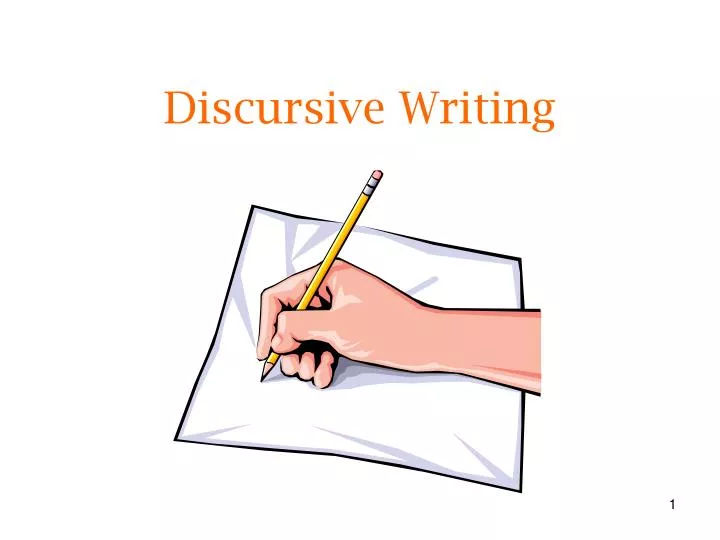
Discursive Writing
Mar 28, 2019
1.89k likes | 4.4k Views
Discursive Writing. What is Discursive Writing?. Discursive Writing: This is the overall title for factual writing where you discuss ideas, express opinions and present evidence to justify your (or other peoples’) viewpoint. Discursive writing includes:
Share Presentation
- past examples
- emotive language
- glorious autumn morning
- which topic
- which style suits

Presentation Transcript
What is Discursive Writing? • Discursive Writing: This is the overall title for factual writing where you discuss ideas, express opinions and present evidence to justify your (or other peoples’) viewpoint. • Discursive writing includes: • Argumentative: where you present a balanced view on the topic. • Persuasive: where you take a side and persuade the reader of your opinion.
Discursive Writing: Exam Questions • There are always around 5 discursive essay tasks in every Standard Grade Exam paper. • The key words in the task which indicate a discursive essay are discuss or give your views.
Discursive Writing: Exam Questions • Here are some past examples you could plan essays for: • 2008: Education is about what we learn both inside and outside the classroom. Give your views. • 2007: What’s going on with our weather? Individuals need to take steps to tackle climate change. Give your views. • 2007: These days young people are unfairly treated by the media. Give your views. • 2006: Look at me! Is it more important to be an individual or to fit in with the crowd? Discuss.
Discursive Writing: Exam Questions • Tasks tend to be centred around topics like: • Education/school • Young people/youth culture • Technology • Environment • Revision Tasks: Look through your Past Papers and decide which topic heading each task comes under. • Are there any other possible topic headings? • Do you think you could write convincingly on any or all of these topics? • Plan essays for all these topics and read up about them so you have some convincing evidence and opinions to use in the exam.
What’s Expected in the exam • Although you should research the topics you will not be expected to produce such detailed and accurate evidence and quotations etc. as you did for your folio discursive essay. • The examiner will recognise that you cannot possibly recreate this standard in the exam and they will not be checking that the statistics or quotations you use are exactly correct (although don’t just make up nonsense!) • They will be looking for how developed your reasoning is, your structure and the sophistication of your language.
Structure Introduction Arguments & counter arguments Conclusion LINKING: connectives and topic sentences Content Quality ideas Development of ideas Supporting evidence Fact and opinion Step by Step Guide • Style • Persuasive or argumentative? • Formal • Present tense • Rhetoric • Emotive Language
Step by step in the ExamStep 1: Choosing your task. • Pick something relevant to you. • You are going to have to demonstrate knowledge and understanding of your issues, without the ability to do any reading or research, so it is best if you choose something in which you have a genuine interest and on which you have a genuine opinion. • If you have revised and researched the topics listed previously, then you should have opinions and evidence for most of the questions which arise.
Persuasive Where you give your personal opinion on a topic or issue, and endeavour to persuade the reader to your way of thinking. Works best if you are genuinely committed to the issue. Argumentative Allows you to consider, in a balanced way, the pros and cons of a particular topic or issue. Useful if you feel there are strong arguments on a least two sides of the issue or topic. Step 2: Persuasive or argumentative?
Step 3: Structuring your Essay • Argumentative Essay Structure: • Opening statement – giving OPINION • Series of paragraphs: • Arguments for x 3 • Arguments against x3 • Summary / Conclusion • Restating opinion
Step 3: Structuring your Essay • Persuasive Essay Structure: • Opening statement – giving OPINION • Series of paragraphs each containing the following: • Counter-argument • Refute counter-argument • Summary / Conclusion • Restating opinion
Step 3: Structuring your Essay • Persuasive writing: how to structure each paragraph using counter-arguments. • 1. Give an opinion which goes against your argument • Some people believe • It has been said that • There are those who say • 2. Make a statement say the opinion given is WRONG! • However this is not the case. • This is far from true. • Clearly this is unfounded.
Step 3: Structuring your Essay • 3. Give your own opinion (counter-argument) • In actual fact • In my opinion • The truth is that • In my view • I believe / I feel • I am convinced
Step 4: considering style General Language Features for all discursive writing: • First Person (persuasive) OR third person (argumentative) • Present Tense • Topic Sentences • Connectives (linking words and phrases – see next slide) • Phrases to give own opinion • Rhetorical Questions – to pose the issue and involve readers • Similes / Metaphors • Exclamations - to make dramatic point
Step 4: considering style • USING CONNECTIVES • 1. To give sequence /structure to whole text • e.g. firstly secondly, thirdly etc • 2. To connect CAUSE and EFFECT, linking points within paragraphs • e.g consequently, as a result, therefore • 3. To COMPARE and LINK DIFFERENT arguments • e.g. however, on the other hand, but
Step 4: considering style • PERSUASIVE TECHNIQUES: These techniques are mainly used in persuasive writing although they can sometimes in argumentative writing: • Rhetorical questions: How could you possibly consider letting this poor dog die? • Appeal directly to the audience: You have the power in your hands to save this dog. • Emotive language: This poor, weak, defenceless creature should be spared. • List in Threes: This poor, weak defenceless creature. • Commands: Vote to save a life today!
Step 4: considering style • Surely there is no one in this world who enjoys ploughing their way through a mountain of these, foul-tasting vegetables! • Persuasive words/phrases: surely, obviously, undeniably, certainly. • Imagery and exaggeration: mountain of, ploughing through.
Do Write in proper, complete sentences Use complete words and expressions Use proper, standard English Do not Use abbreviations (i.e./e.g./etc./UK/&) Contractions (isn't/don't/won't) Slang (e.g. bloke/geezer etc) Colloquial language (mate/bolshy etc.) Step 4: considering style Tonein a discursive essay You should also try to make sure that you use a decent standard of vocabulary In particular, try to avoid weak vocabulary such as 'get', 'got' and 'getting'. Relying on this level of vocabulary too often suggests that your power of expression is weak. Build up your word power!
Step 5: Opening your essay • The following methods are suggestions. It is up to you to decide which style suits your writing best. • Provocative • e.g."It is difficult to see how anyone can approve of fox hunting." • Balanced • e.g."Fox hunting is a subject about which people hold strongly contrasting views." • Quotation • e.g."Oscar Wilde once described fox hunting as 'The unspeakable in pursuit of the uneatable.'." • Illustration • e.g."On a glorious autumn morning a terrified, exhausted animal is savaged to death by a pack of baying dogs while a group of expensively dressed humans encourage the dogs in their bloody work." • Anecdote • e.g."I have always detested fox hunting since I was almost physically sick while watching a television film of the kill at the end of a hunt."
Step 5: Opening your essay • Rate the following introductions. Which is best? Why? • My essay is going to be about living in the town and the country. In this essay I will look at both sides of the argument. • Deciding whether to live in the town(city) or the countryside can be difficult, as there are many reasons why both locations might be attractive. However both choices also offer a number of disadvantages which can put people off. • City life: bright, exciting, challenging. Rural life: peaceful, idyllic, relaxing. How do you choose between two such different locations when making the crucial decision of where to live?
Step 6: Using topic sentences • Given the choice, many people prefer to live in the country. Onereason for this is… • The countrysidealso… • Furthermore, living in the countryalso… • Additionally, country living means that … • On the other hand , many people feel that country living… • But rural life is not always… • However not everybody agrees that living in the country is… Another problem with living in the country is…
Step 7: Concluding your essay • Rate the following concluions. Which is best? Why? • To finish my essay I am going to sum up my ideas for and against living in the town and living in the country. • In conclusion there are many good reasons to live in the town, but there are also many good reasons to live in the country. I think I would prefer to live in the town. • To conclude, deciding whether to live in the town or the country is a very personal decision. Whilst some people adore the hustle and bustle of the city, other much prefer the tranquil world of the countryside. Having lived in both, I can honestly say that the many amenities and the ‘bright lights’ of the city are what appeal to me most. I definitely prefer living in the city.
- More by User

Discursive Persuasive
CONTENTS. 1.Introduction: Writing to handle ideas - discursive
953 views • 66 slides
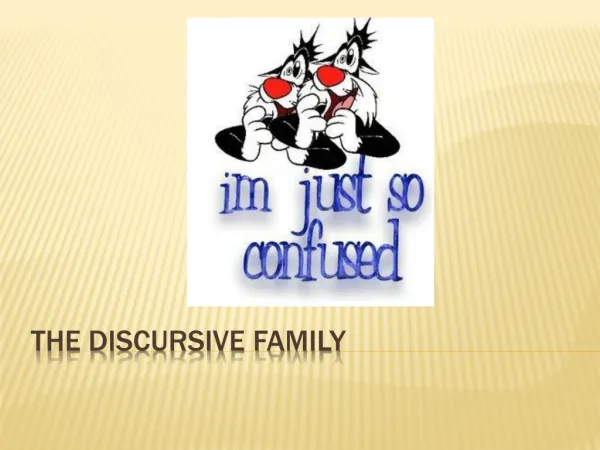
The Discursive Family
The Discursive Family. http://www.debatingmatters.com /. For Topics/ Credible Evidence. An argumentative essay is one in which you examine and evaluate objectively* opposing viewpoints on a controversial topic.
455 views • 15 slides
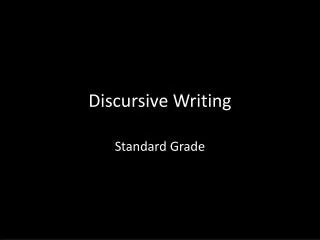
Discursive Writing . Standard Grade . What is it?. Firstly, in your pairs write a definition of what discursive writing is. Next write the criteria for what you think the characteristics of good discursive writing would be. . Techniques . P ersonal pronoun. E motive word choice.
519 views • 16 slides
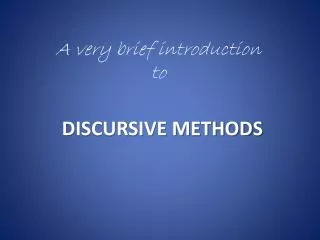
DISCURSIVE METHODS
DISCURSIVE METHODS. A very brief introduction to. DISCURSIVE METHODS. Conversation Analysis Discourse Analysis Critical Discourse Analysis. Why Language?. The ‘discursive turn’ driven by social constructionism
598 views • 25 slides
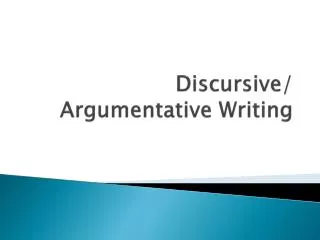
Discursive/ Argumentative Writing
Discursive/ Argumentative Writing. Writing Folio. Two pieces of writing form different genres. One reflective/ creative One discursive / persuasive One fifth of total award . Argumentative writing.
526 views • 29 slides

3.1 Discursive Writing
3.1 Discursive Writing. 3.1 Discursive Writing. School Uniform Should school uniform be banned?. 3.1 Discursive Writing. In today’s lesson: d evelop knowledge and understanding of the structure and style of a discursive essay. Opening your essay. Opening your essay. Provocative
320 views • 12 slides

The Discursive Family . http://www.debatingmatters.com /. For Topics/ Credible Evidence . An argumentative essay is one in which you examine and evaluate objectively* opposing viewpoints on a controversial topic.
270 views • 15 slides
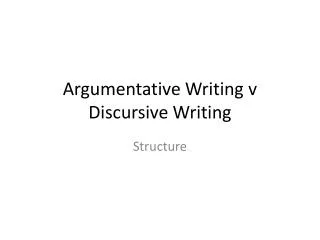
Argumentative Writing v Discursive Writing
Argumentative Writing v Discursive Writing. Structure. Discursive Writing. The structure of discursive essays is traditional . You should remain impartial and look fairly at both sides of the situation. Discursive Writing.
377 views • 8 slides

Discursive writing
Discursive writing. Characteristics of discursive writing. Taking several lines of argument Presenting lines of argument in an ordered fashion Giving evidence to support the lines of argument Linking coherently each line of argument
213 views • 3 slides
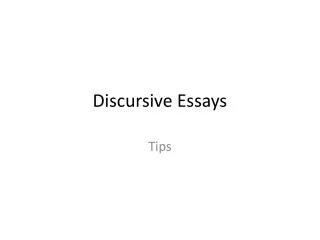
Discursive Essays
Discursive Essays. Tips. Homework Sources. When you have decided on your title, Google it. Look for newspaper articles on the topic. Remember to stick to reputable papers, ideally broadsheets. The Irish Times or The Times are good sources.
245 views • 5 slides

INSTITUTIONAL AND DISCURSIVE OPPORTUNITY STRUCTURES
INSTITUTIONAL AND DISCURSIVE OPPORTUNITY STRUCTURES. MARCO GIUGNI (Universidad de Ginebra). Con la colaboración y financiación de:. CONCEPTUAL FRAMEWORK. POLITICAL OPPORTUNITY STRUCTURE. Individual rights Cultural group rights General political opportunity structure
437 views • 30 slides

Discursive Writing. This task should be linked to the debating unit Choose your topic Prepare your debating speech arguing one side of the case Then in your groups pool your resources and come up with a list of points for and against. Topics. Boarding schools School Uniform Designer Goods
404 views • 9 slides
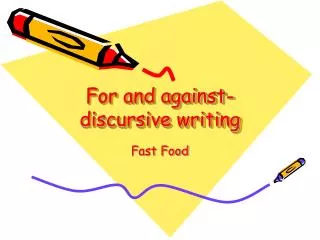
For and against- discursive writing
For and against- discursive writing. Fast Food. The advantages and drawbacks of Fast Food. Introduction: Use a “hook” to catch the reader’s attention e.g. a question which you answer later OR a shocking statistic which you return to in the end. Define what fast food is.
425 views • 15 slides
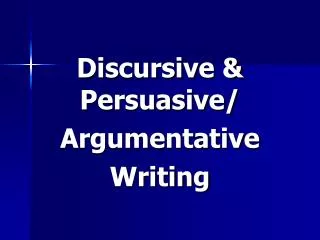
Discursive & Persuasive/ Argumentative Writing
Discursive & Persuasive/ Argumentative Writing. CONTENTS. 1. Introduction: Writing to handle ideas - discursive & persuasive/argumentative writing (slides 3 – 6) 2. Subjects to avoid (slides 7 – 8) 3. Researching my essay (advice) (slides 9 – 15)
1.04k views • 67 slides
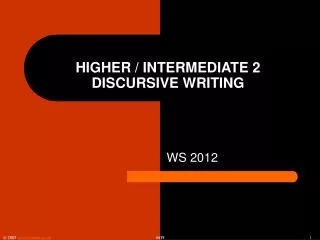
HIGHER / INTERMEDIATE 2 DISCURSIVE WRITING
HIGHER / INTERMEDIATE 2 DISCURSIVE WRITING. WS 2012. ARGUMENTATIVE PROVIDES INFORMATION COVERING BOTH SIDES OF THE ISSUE. TRIES TO BE FACTUAL AND UNBIASED. THE CONCLUSION WEIGHS UP BOTH SIDES OF THE ARGUMENT AND SUGGESTS ON BALANCE, THE BEST OPTION. PERSUASIVE
293 views • 15 slides

HOW TO WRITE A DISCURSIVE ESSAY
HOW TO WRITE A DISCURSIVE ESSAY. PLANNING. Planning is key to a successful essay Always make a list of for and against arguments first. Make sure that you have sufficient arguments for both sides of the point Use evidence to support your point. STRUCTURE. Introduction
221 views • 14 slides

Discursive Writing. Choose a topic which people have strong feelings about Examine both sides of the issue Give your personal opinion in the conclusion. Suggestions for discursive writing. Stem cell research- which uses aborted foetus cells Euthanasia- the Dignitas debate
179 views • 11 slides
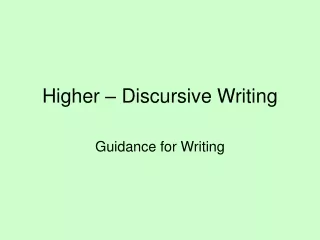
Higher – Discursive Writing
Higher – Discursive Writing. Guidance for Writing. Types of Discursive Writing. Argumentative - Examine opposing viewpoints objectively using formal and neutral language. - You should use authoritative sources. Persuasive
197 views • 19 slides

Discursive Writing. Putting your point of view across. Discursive/ Argumentative. Discursive Writing : Writing that requires providing points for “and” against. ex. Experiments on animals are neither good nor bad
205 views • 13 slides
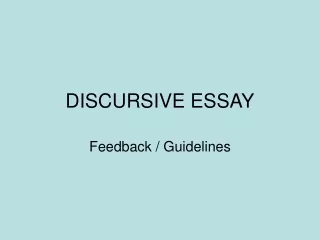
DISCURSIVE ESSAY
DISCURSIVE ESSAY. Feedback / Guidelines. Structuring Your Essay. Introduction Capture the reader’s attention Make the topic clear including relevant background information. DON’T presume the reader knows what you are talking about.
221 views • 10 slides

IMAGES
VIDEO
COMMENTS
Organising a discursive essay. There are two basic types of discursive essay. Firstly there are persuasive essays in which you can argue strongly either in favour of or against a given discussion ...
A discursive essay is a form of critical essay that attempts to provide the reader with a balanced argument on a topic, supported by evidence. It requires critical thinking, as well as sound and valid arguments (see Chapter 25) that acknowledge and analyse arguments both for and against any given topic, plus discursive essay writing appeals to ...
1. Introduction: Hook: Begin with a captivating hook or attention-grabbing statement to engage the reader's interest. Contextualization: Provide a brief overview of the topic and its relevance, setting the stage for the discussion. Thesis Statement: Clearly state the main argument or the purpose of the essay.
27. Writing and Formatting a Discursive Essay. The previous chapter describes a discursive essay as a form of critical essay that attempts to provide the reader with a balanced argument on a topic, supported by evidence. This chapter examines the structure in increased depth.
Don't know what a discursive essay is? Do you know what the differences between a discursive and persuasive essay are? Don't worry. In this article, we explain what discursive writing for Year 12 Module C: The Craft of Writing is and give you a step-by-step process for writing a discursive essay.
Step-by-Step Discursive Essay Writing Guide Selecting a Topic. Selecting a topic for a discursive essay is a crucial first step in the writing process. Here are some considerations to help you choose an appropriate and engaging topic: Relevance: Select a topic that is relevant and holds significance in the current context.
Tone. The discursive essay is a formal essay that requires a formal tone. This means that you'll write in third person point of view to evaluate arguments and express your opinion. You'll also need to use formal word choices to keep the tone of your essay in check. In other words, don't write this:
The reading of a model text, so important in a product driven approach to writing, is not so as to subjugate the students' ideas to their organisation, but so as to make students aware that there is a particular way to express their ideas. In this way students are given the form in order to enable them to adapt it to carry their own meaning.
It helps develop the meandering tone which is characteristic of the no-bias and thought provoking nature of discursives. A discursive takes readers on a journey. It is written to explore both sides of an issue, not persuade. Low modality and speculative. Once again, a discursive should not take a clear stance.
The Academic Writing Guide (AWG) is designed to familiarise you with the process of writing a discursive essay. A discursive essay is a genre of writing that requires you to investigate a topic; collect, generate, and evaluate evidence; and establish a position on the topic in a concise manner. Once you have decided on your position your ...
3. For and against essay. Write it as a debate with opposing opinions. Describe each viewpoint objectively, presenting facts. Set the stage for the problem in your discursive essay intro. Explore reasons, examples, and facts in the main body. Conclude with your opinion on the matter.
The points you use while writing a discursive essay need to flow smoothly so that readers could see a logical organization of the work. For this, you can use transition words that'll make your paper easily readable and crisp. For example, if you want to list some points, opt for such words as firstly, to begin with, secondly, lastly, finally ...
Your essay is structured in a manner that argues towards this stand. When writing an argumentative essay, your goal is to persuade, to convince the reader to be in support of your stand. Discursive: you are not required to take an explicit stand on the issue. In other words, you do not need to pick a side. You may choose to pick a side; that ...
A nice, in-depth guide to discursive writing, showing what a discursive piece is and how one is written. Presented by the Academic Wingmen.
NESA defines discursive writing as including: Texts whose primary focus is to explore an idea or variety of topics. These texts involve the discussion of an idea (s) or opinion (s) without the direct intention of persuading the reader, listener or viewer to adopt any single point of view. Discursive texts can be humorous or serious in tone and ...
Discursive texts can be humorous or serious in tone and can have a formal or informal register. These texts include texts such as feature articles, creative nonfiction, blogs, personal essays, documentaries and speeches. Discursive is about exploring a range of perspectives on an argument. We can flicker between two perspectives.
Start with an introduction to the topic. Discuss each essay question in a single paragraph. Begin each paragraph with a powerful issue sentence. Paragraphs with one point usually followed by a counterpoint paragraph. Its style is general for essays as the reader should understand what you stand for.
Discursive writing is a type of content usually found in the form of blogs, articles, essays and speeches. Discursive writing is characterized by being subjective or opinionated in nature and engaging the reader by focusing on questions and ideas. It typically has more than one argument or point of view, all of which are meant to debate with ...
Do you want to learn how to write discursive essays for HSC English? Watch this video lesson from Get A Tutor, where they explain the definition and context of discursive writing in Module C. You ...
discursive writing is texts which primarily focus on exploring an idea or variety of topics in written form. These texts and narratives can involve the discussion of an idea (s) or opinion (s) without the direct intention or purpose of persuading the reader or audience to agree with any single point of view that the writer is discussing.
Well a discursive essay is a genre of writing that asks you to investigate a topic; to gather, read and evaluate evidence; and to present a position on your topic based on the evidence gathered. The structure of a discursive essay is held together with a thesis statement which outlines your argument or your position on the topic. The key aim of ...
Frequently asked questions and exam information related to English Module C: The Craft of Writing. We are making the NESA online experience better for you. NESA content will soon be improved and moved to a new location on the NSW Government website so it is easier to find and read.
What is Discursive Writing?. Discursive Writing: This is the overall title for factual writing where you discuss ideas, express opinions and present evidence to justify your (or other peoples') viewpoint. ... Step 4: considering style General Language Features for all discursive writing: • First Person (persuasive) OR third person ...